1lumen selects and reviews products personally. We may earn affiliate commissions through our links, which help support our testing.
Fenix HM71R review
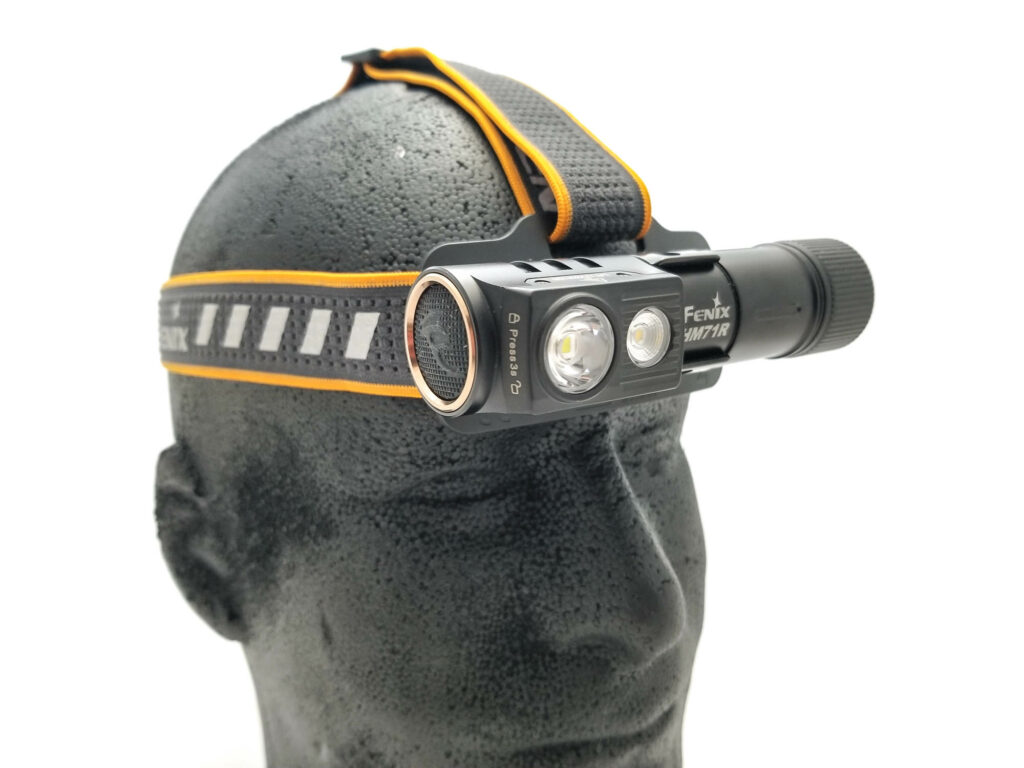
Fenix HM71R specs
| Brand & Model | Fenix HM71R |
|---|---|
| Flashlight category | Right Angle Headlamp |
| LED | Luminus SFT70, Luminus SST20 |
| Max. output | 2700 lumens max |
| Max. beam distance | 230 meters |
| Max. beam intensity | 13,300 cd max |
| Battery config. | 1×21700 |
| Onboard charging | Onboard USB type C |
| Modes | 8 |
| Blinkies | None |
| Waterproof | IP68 |
| Review publication date | May 2023 |
Review intro:
Count on Fenix to innovate. As a large, global manufacturer of illumination tools, they leverage deep pockets, industry insight, and can flex some pretty big R&D muscles to design and develop new lights, and improve on existing models. I’ve reviewed no less than four second, and even a third edition flashlight from Fenix, so yah, they keep getting better and better. Fresh off the pretty awesome Fenix HM70R headlamp, it’s on to another one from the orange and black camp, and this one’s a doozy.
Today we’ll be taking a look at the newest member of the HM7xx series professional-use headlamp segment, and it sort of occupies a smallish corner of the headlamp space. Known as the HM71R, this is a brand-new headlamp from Fenix, and it’s sporting some great specs, with the short list including a special, never-before-seen-in-a-headlamp LED, simple UI, rock-solid ruggedized construction, 21700 size battery, and a stout magnetic tailcap. It’s a totally different animal than the HM70R, and is stacking up to be an incredibly handy unit. Let’s see!
Package quality.
The HM71R comes in a nearly identical package as the Fenix HM70R. It’s a compact, rectangular box, good for retail with a hang tag, in the familiar Fenix-centric orange and black color scheme. Like the HM70R, this one’s also made from thin film plastic, so it’s pretty shiny and sturdy. The headlamp comes assembled and connected to the headband mount, with the battery inside the tube. Here’s what you get:
- Fenix HM71R headlamp
- Fenix ARB-L21-5000 21700 battery
- Spare o-ring
- USB type C cable
- Headband (attached)
- Warranty card
- Manual
This is everything you need to get going, even if you’ve never owned a headlamp or a 21700 battery. All good stuff from Fenix. You also don’t need a battery charger thanks to the onboard charging as any 5 volt output wall wart will suffice. There was also a plastic isolator in the tailcap to prevent the battery from being drained during storage, so make sure to remove the isolator before use. The battery was sitting at 3.63 volts.
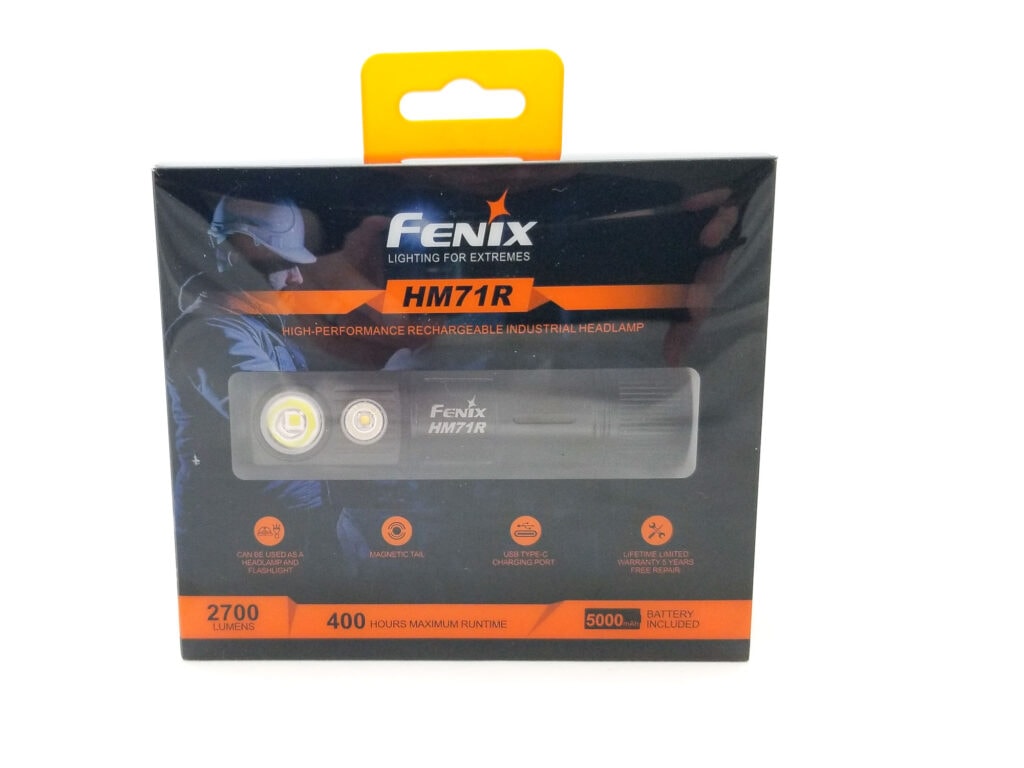
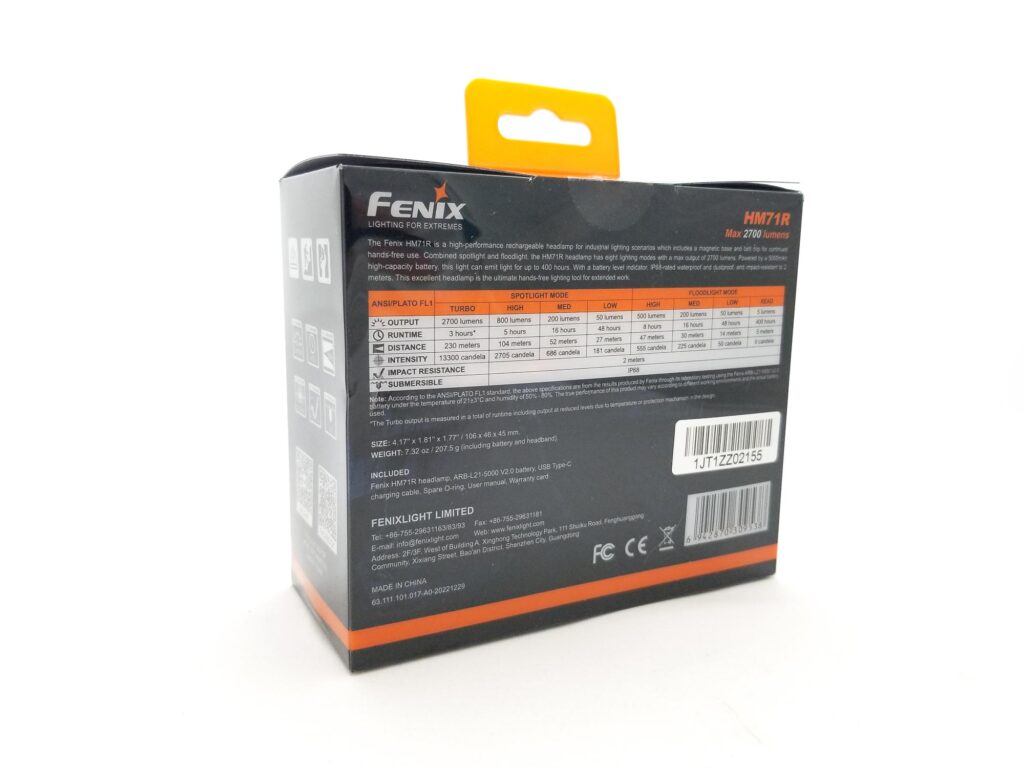
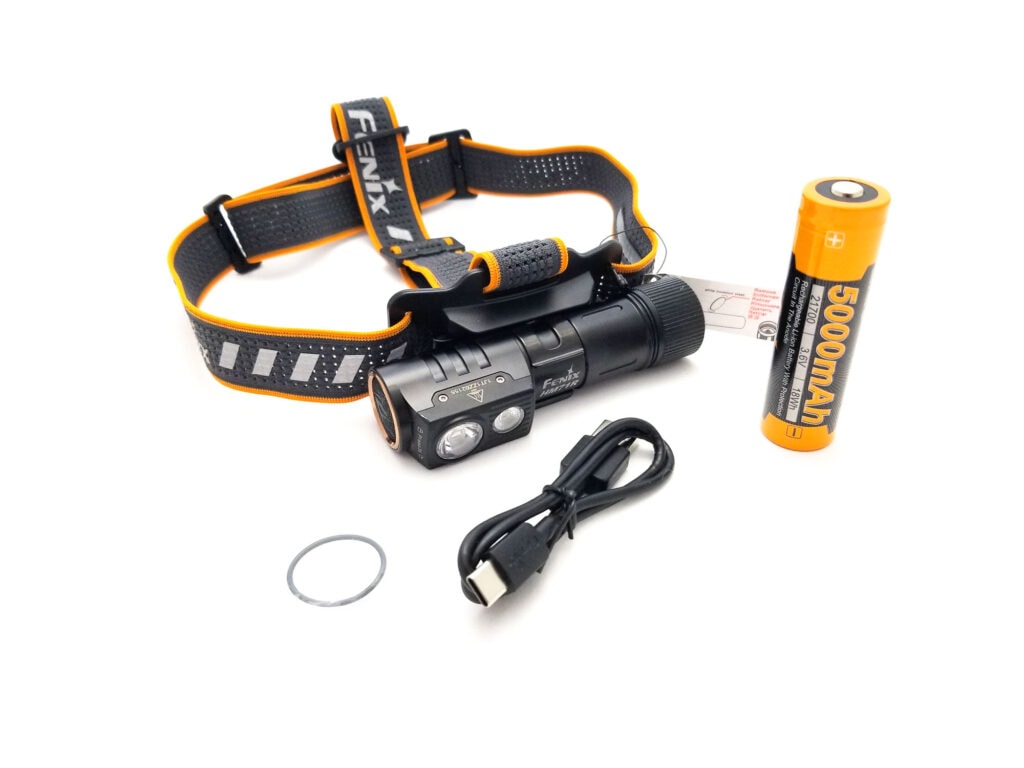
Flashlight in use
The HM71R is a general purpose headlamp, and thanks to the dual LED option, it’s very versatile and adaptable. This is a right angle headlamp, with the LEDs situated on one end of the tube opposite the tailcap. Right angle headlamps are cool and have their place, but in my opinion, I think T-type headlamps like the Fenix HM70R are better adapted to dedicated headlamp duty. Right angle headlamps are great general purpose lights.
The HM71R is special in that it can be quickly detached from the headband’s mount and go handheld, or easily be mounted for headlamp use. It has a sturdy stainless steel PVD coated pocket clip that’s friction fit to the tube with a very wide clip. It’s still able to rotate smoothly, but is unlikely to be jarred loose. You can clip the light to a shirt pocket, collar, vest, sleeve for hands-free action, and thanks to the properly strong magnet in the tailcap, it sticks like Spider Man to anything metal and can even hold itself at a right angle on a pretty small contact patch.
It makes a fantastic drop light or work light when used that way.
The headband is Fenix’s signature 3-band design, which is just about mandatory for hard hat or helmet use since it absolutely will not slip downwards, and that’s further helped by the addition of grippy silicone stips on the inside of the band. The band also has reflective elements for extra visibility at night. It has adjusters on each band for easy adaptability to a wide variety of head sizes and I found it easy to adjust. The headband mount is made from really sturdy ABS plastic and is designed so the HM71R pocket clip is captured so the light can be mounted and removed easily. It’s a great system.
The large 21700 size battery lends itself to longer runtimes and higher output, and while I think 18650 size headlamps strike the best balance of output, runtime, size, and weight, that doesn’t seem to hurt the HM71R’s handling or maneuverability one iota. It’s pretty lightweight, easy to handle, and the large top-mounted e-switch has a huge grippy boot. It’s mounted in a depression in the top of the tube, and was super-easy to find by feel.
The switch action is great with good feedback and positive clicks. Gloves would not be a problem here. The 21700 battery compartment makes up a large part of the body of the headlamp, with the LEDs mounted in what looks like a removable housing held on with Torx fasteners. Fenix says this is made from stainless steel for added durability, and that’s great since this light is meant to be used…hard. The charge interface is on the backside of the head and covered by a sturdy rubber flap that makes a great seal. There’s a single LED indicator located on the switch boot for on and charge state as well. Tail standing is easy peasy, and you can thread a lanyard through the pocket clip.
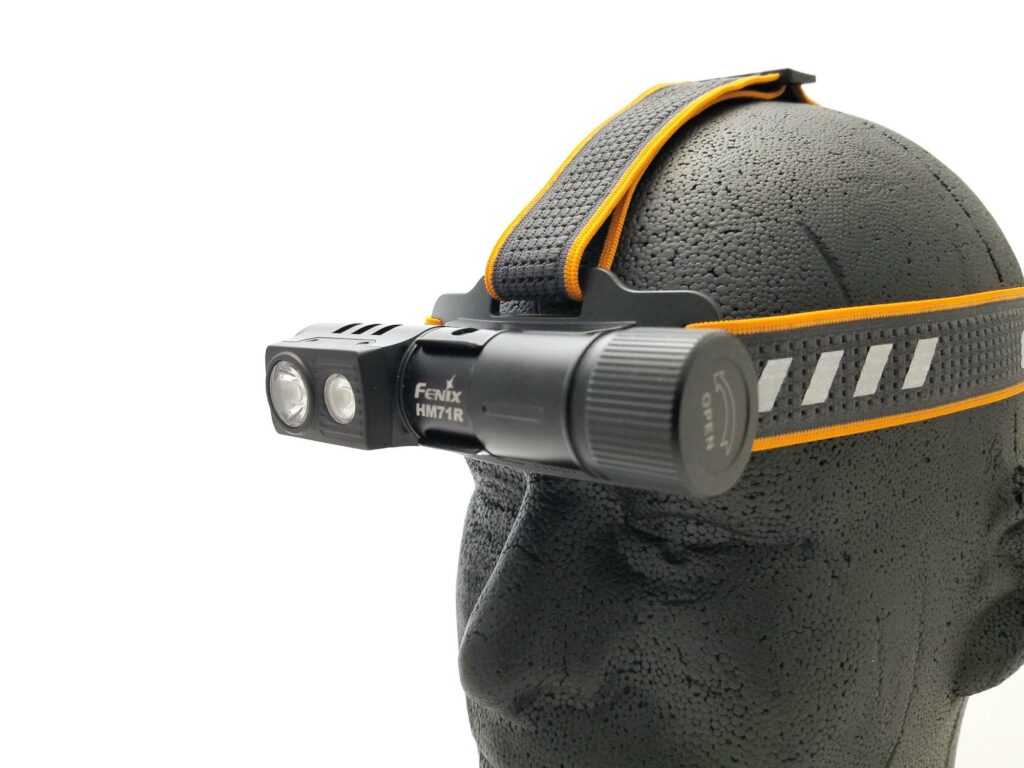
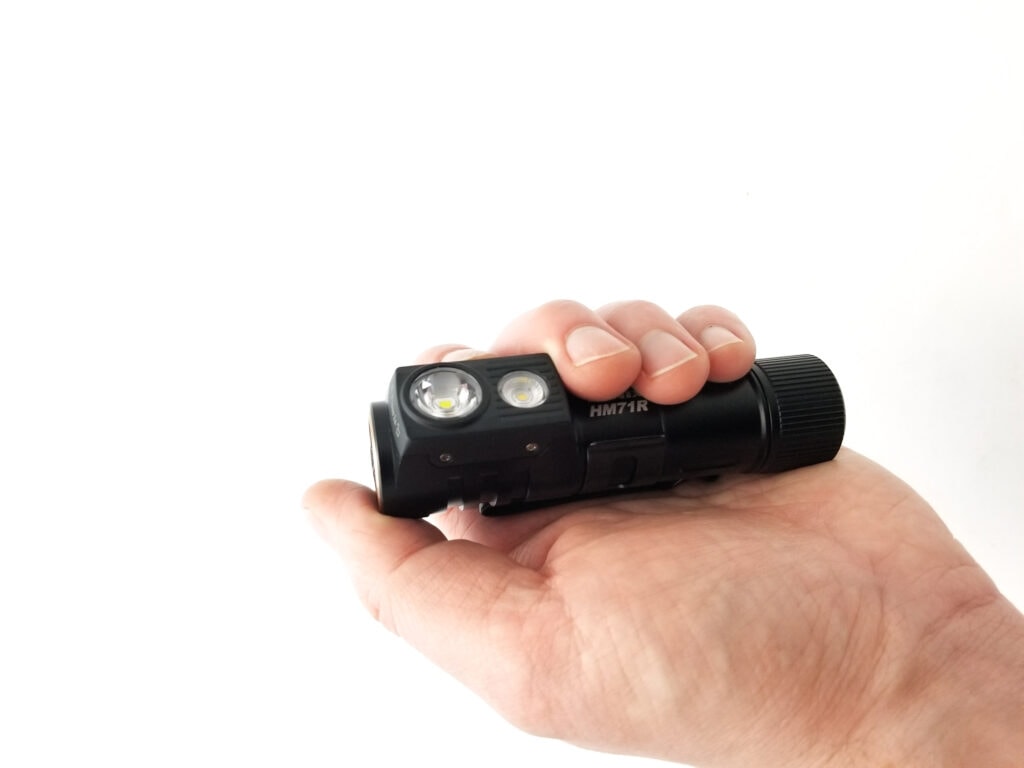
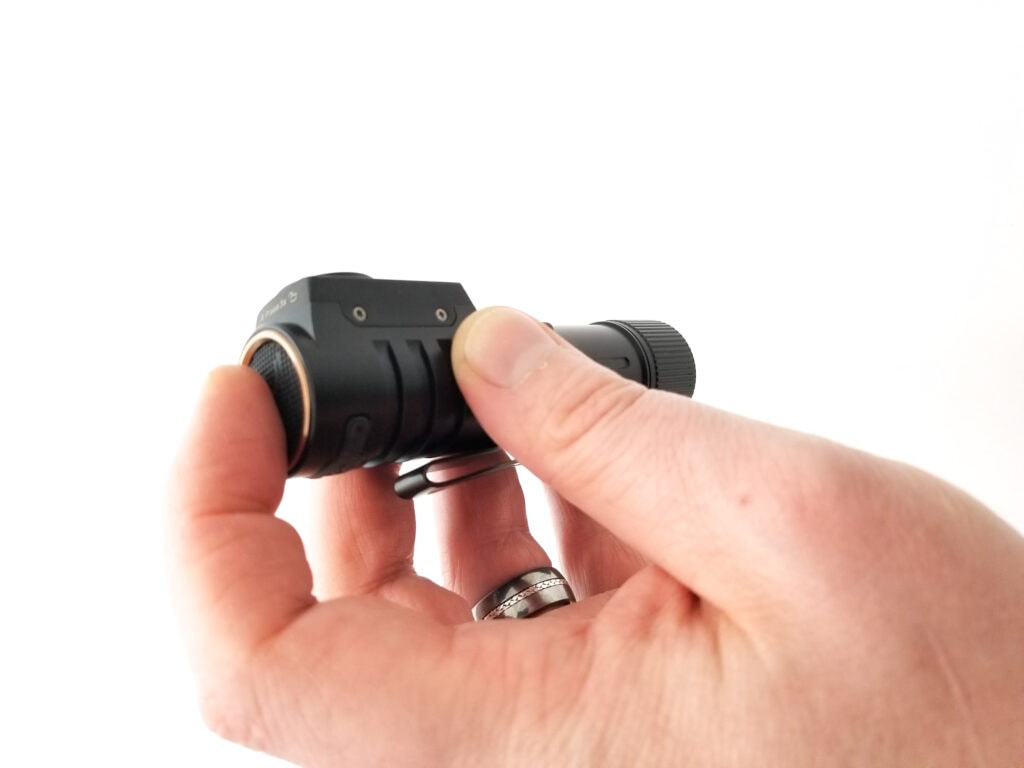
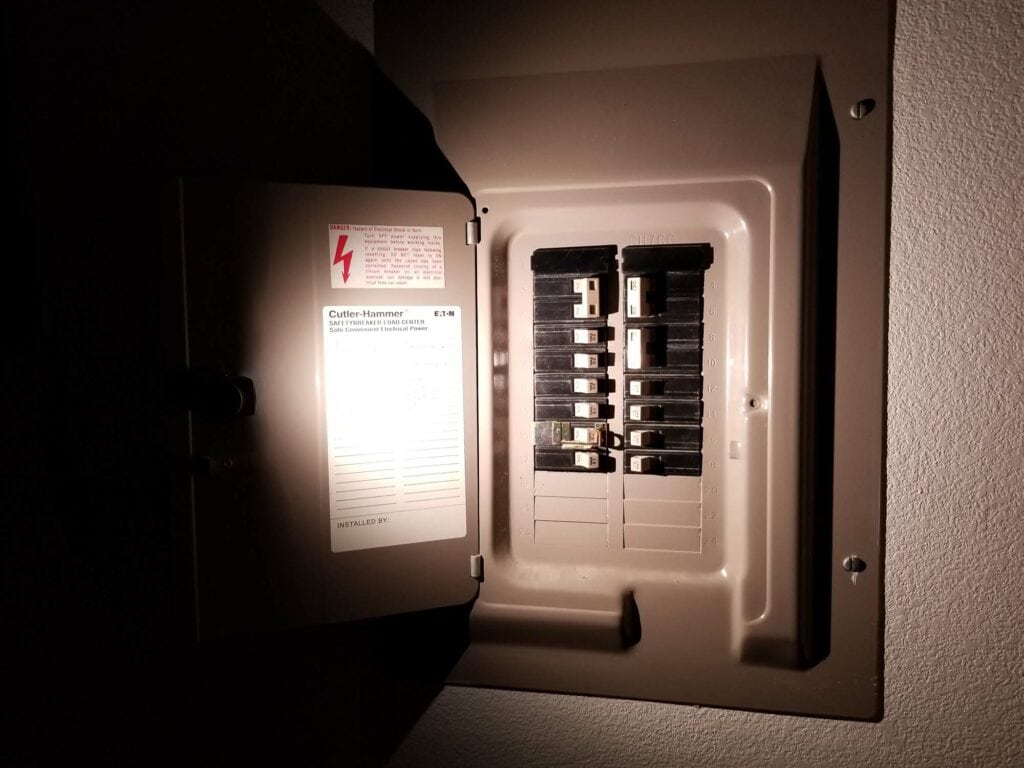
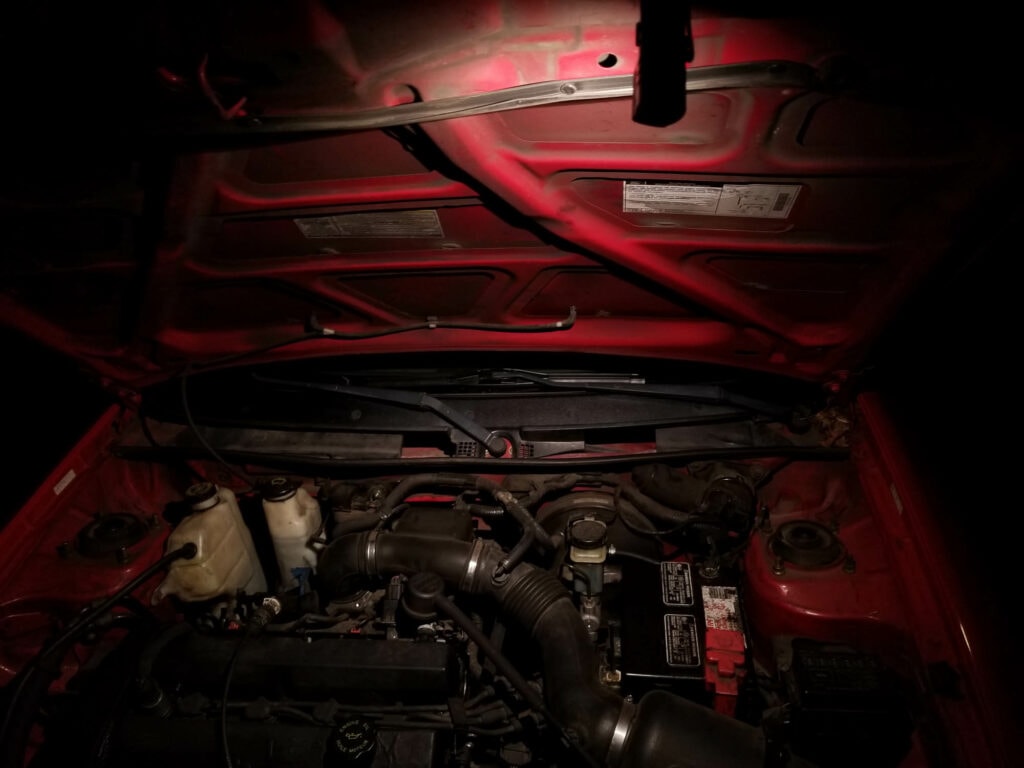
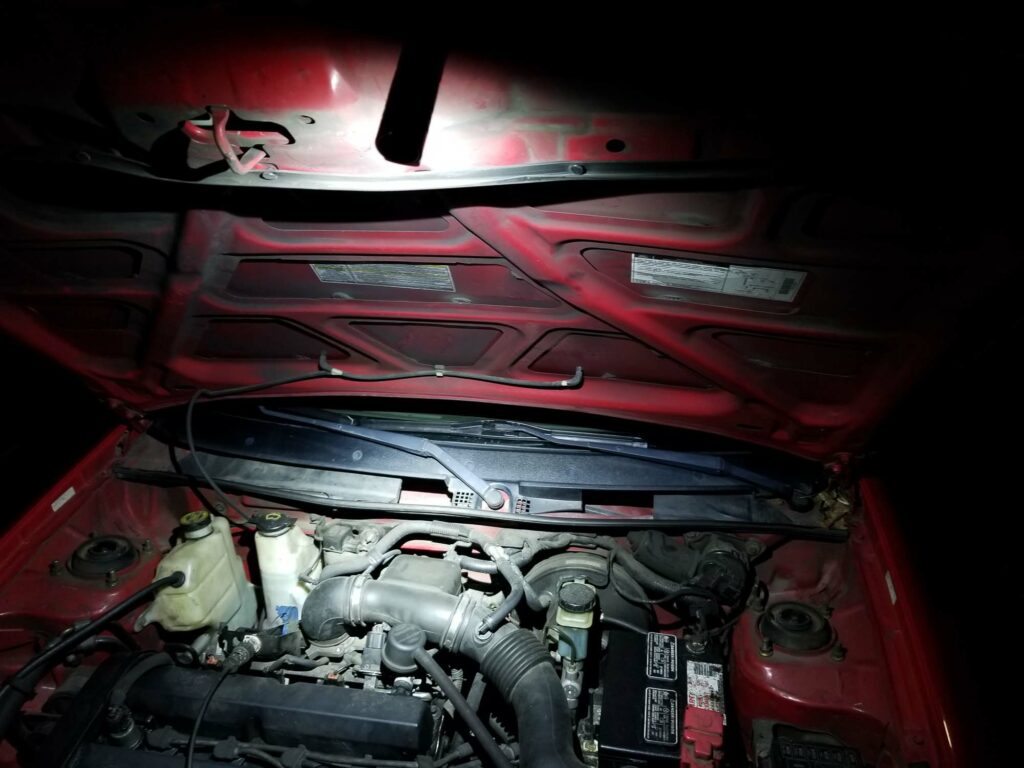
Build Quality and Warranty
It’s sort of a broken record when it comes to Fenix’s build quality and attention to detail, and it makes sense because professional-use lights require tight quality control. We all know quality isn’t cheap, and the HM71R carries a street price around $120 US. That’s a lot when you could buy a Sofirn HS40 and a Cyansky HS6R for that price. I digress though, because it’s totally worth the price of admission. Build quality is superb. The parts fit together perfectly with no obvious gaps or misaligned parts. The headlamp body is precisely milled from 6061-T6 aircraft grade aluminum. The headlamp design is pretty unique.
The LEDs are contained in a separate housing attached to the headlamp body with four T-5 Torx fasteners. Fenix says it’s made from bead blasted matte finish black PVD coated 316 stainless steel. This is a smart move because it’s more durable than aluminum and tough, so it can take more abuse from drops or bumps. It’s also very corrosion resistant unlike aluminum, and can withstand humid environments and exposure to salt water. The machining is perfect with no sharp or abrupt edges anywhere. The finish is advertised as type III HA, and it’s more glossy than matte finish, but it’s perfectly done and looks like it could take some serious abuse.
Like the HM70R, this one also has a potential weak link with the absence of a driver spring, which instead has a flat contact with an interference bar for reverse polarity protection. The tailcap has a single copper alloy spring and it’s decently thick and gold plated for low resistance. It has a stout magnet under the spring. I’d have liked to see dual springs here on a working-class light since they prevent connection breaks under shock loading and protect the driver from damage. The battery access cover is o-ring sealed, and the thread are fully anodized and feature stout rectangular cut threads. They were very nicely lubed and super sssmmootthhh. Fenix rates the HM71R to 2 meters for impact resistance and IP68 for water and dust resistance, so it would be good in all weather conditions.
For the warranty, it’s commensurate with the competition and one of the more robust in the industry. Take it away Fenix: Open Air Brands LLC, dba Fenix Lighting US, guarantees all Fenix products purchased from retailers to be made of first-class materials and therefore provides a lifetime warranty against any defects in material and workmanship. Excluded from warranty coverage is any damage to the exterior deemed reasonable wear and tear such as scratches and/or fading of color. In addition, the warranty does not apply to damage caused by abnormal or unreasonable use of any of the components. This includes use of unapproved batteries in Fenix products (see user manuals). This warranty is in place of all other warranties, including warranty of fitness for a particular purpose and warranty of merchantability and excludes any liability for incidental or consequential damages. If your Fenix product has a manufacturer’s defect covered by our warranty, we will either repair or replace it, at our option, without charge. Most damaged Fenix products not covered by the warranty can still be repaired. If repair costs and handling charges apply, you will be notified prior to any service.

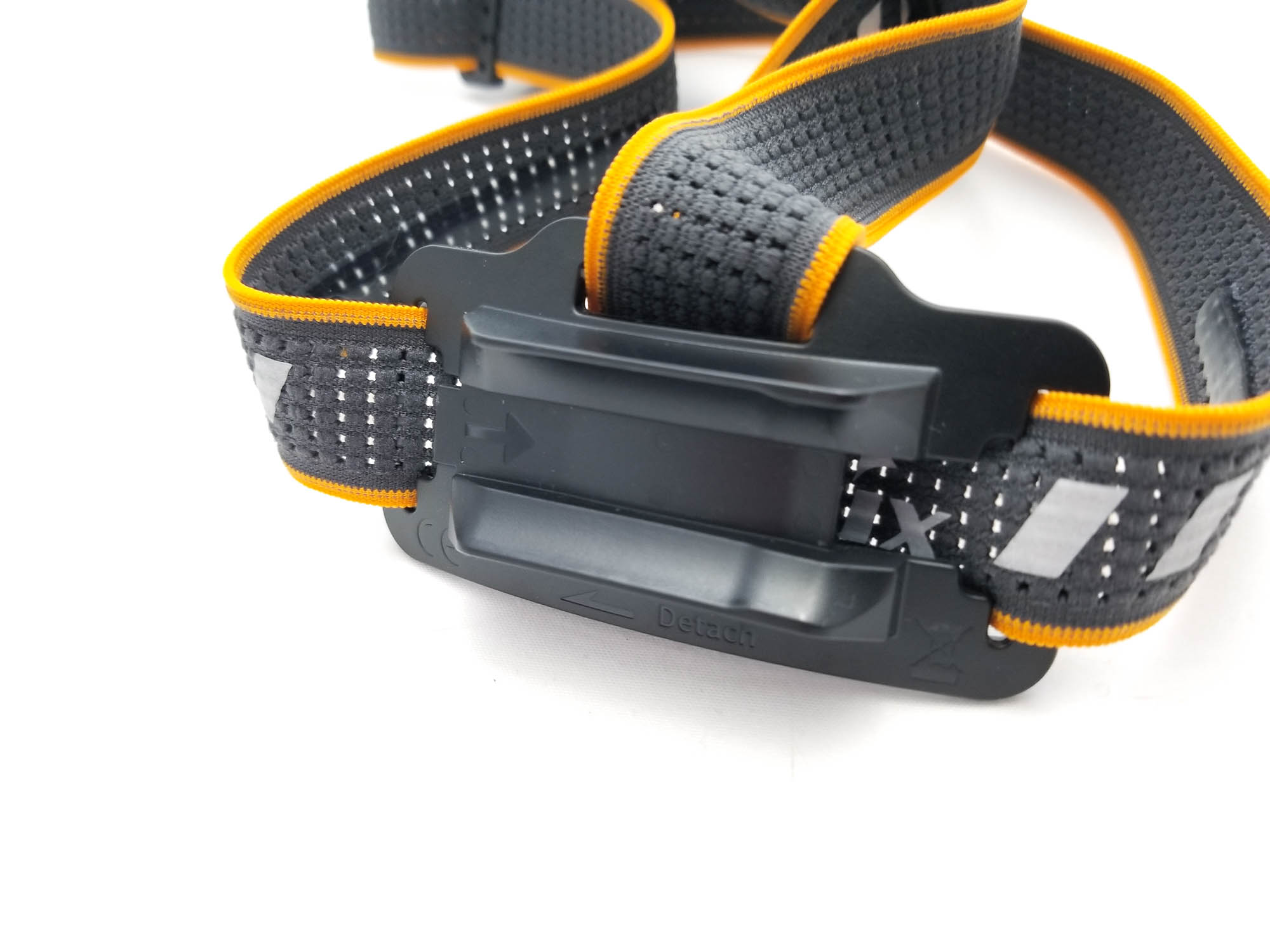
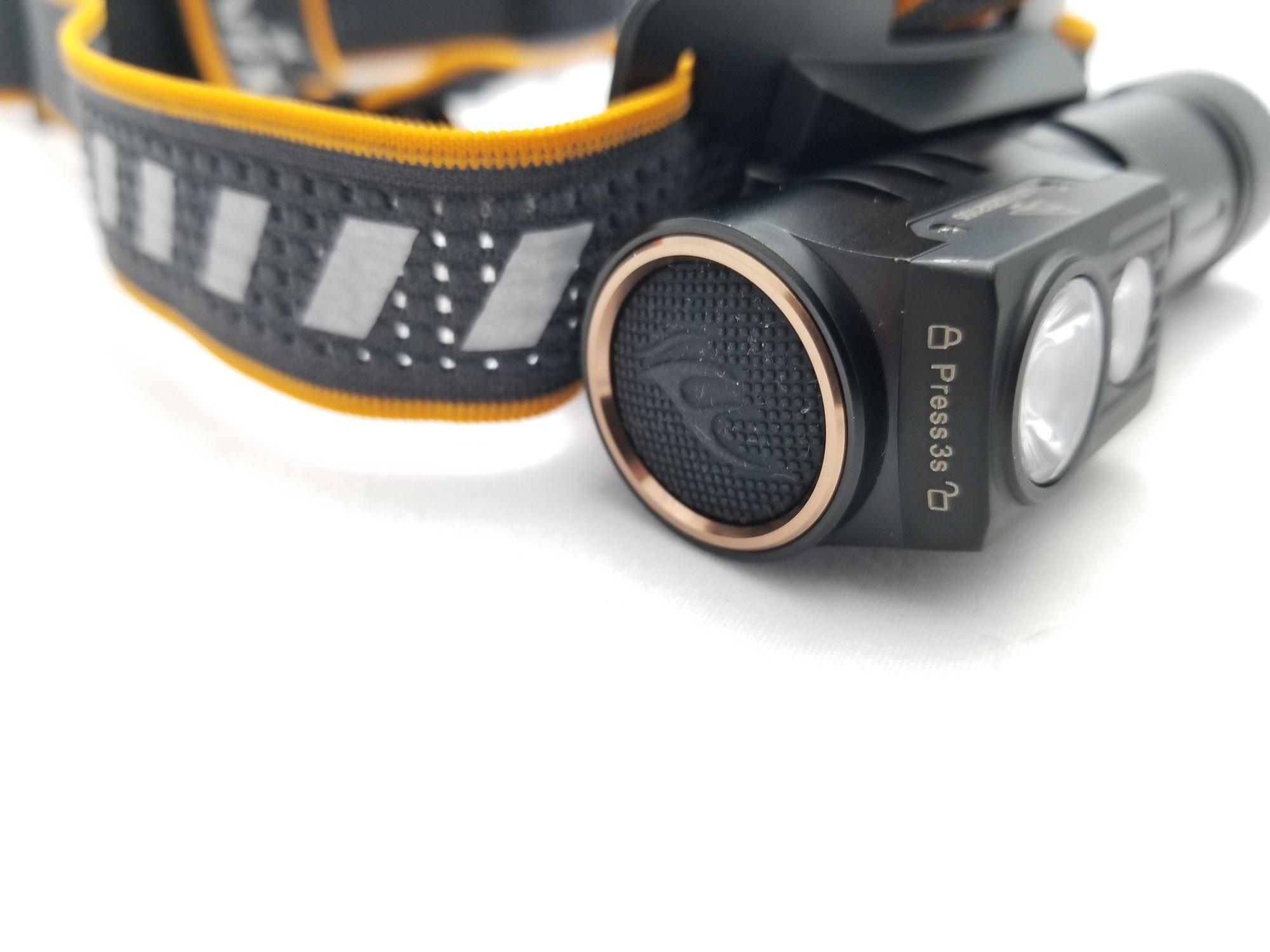
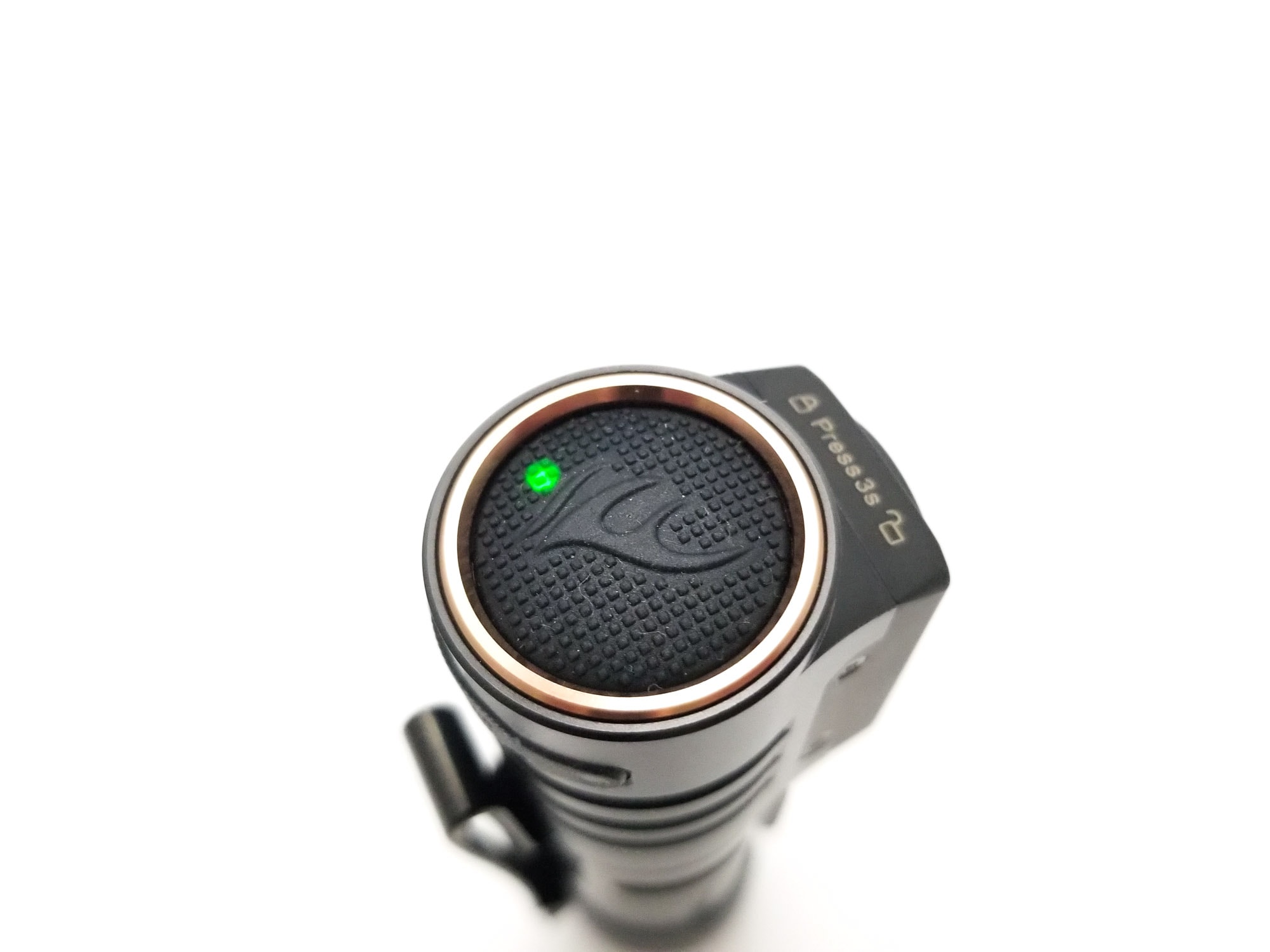
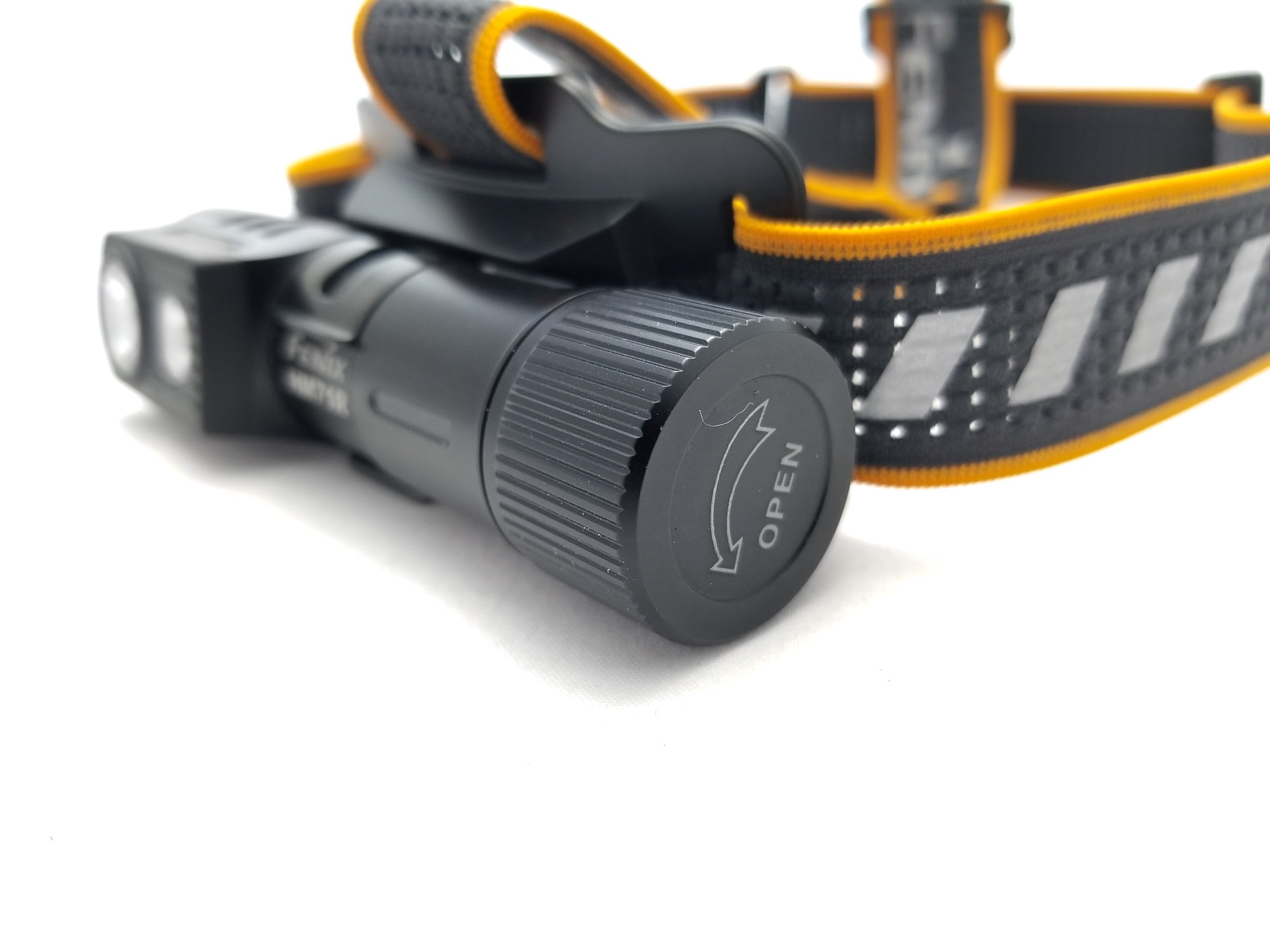
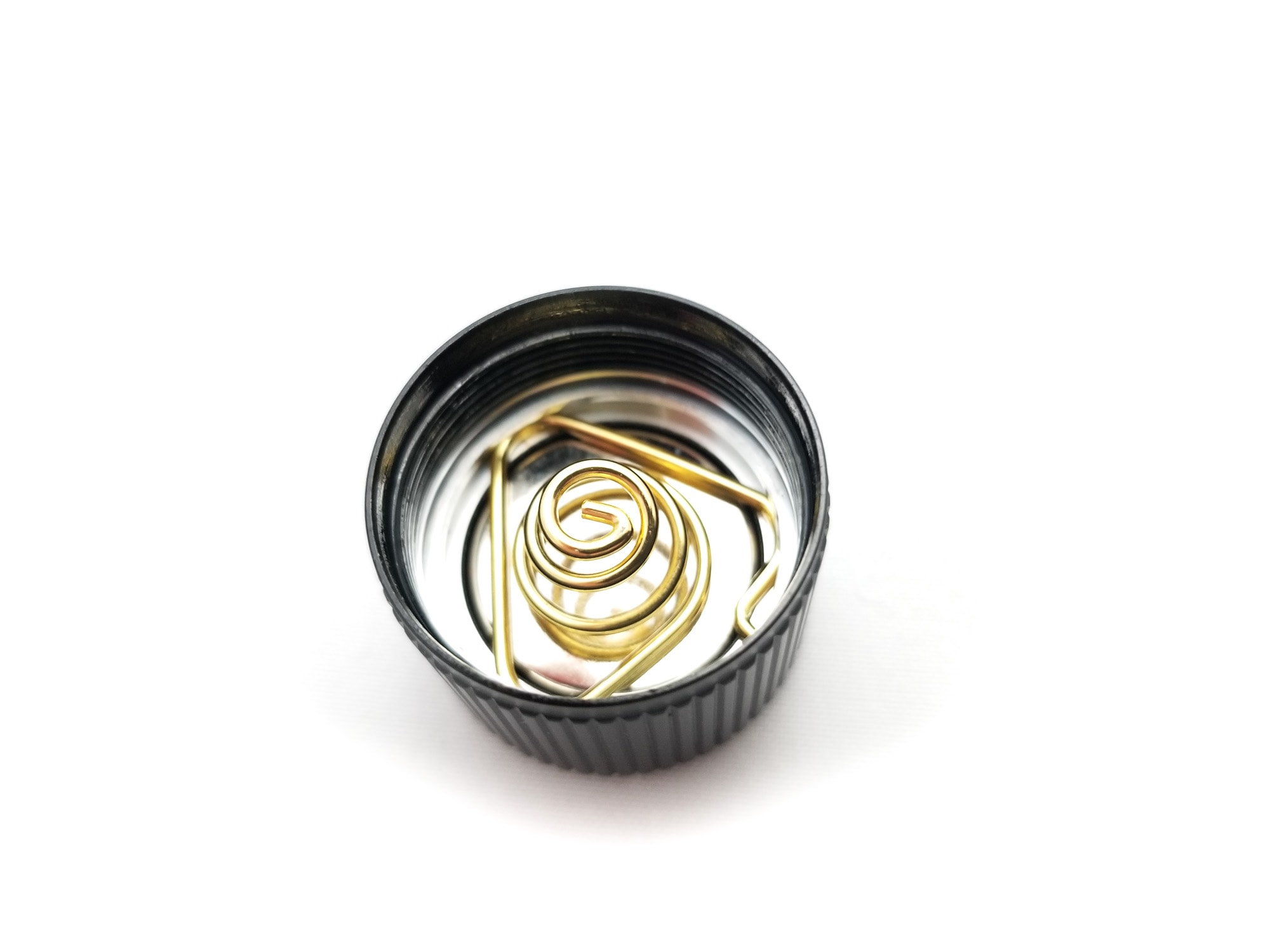
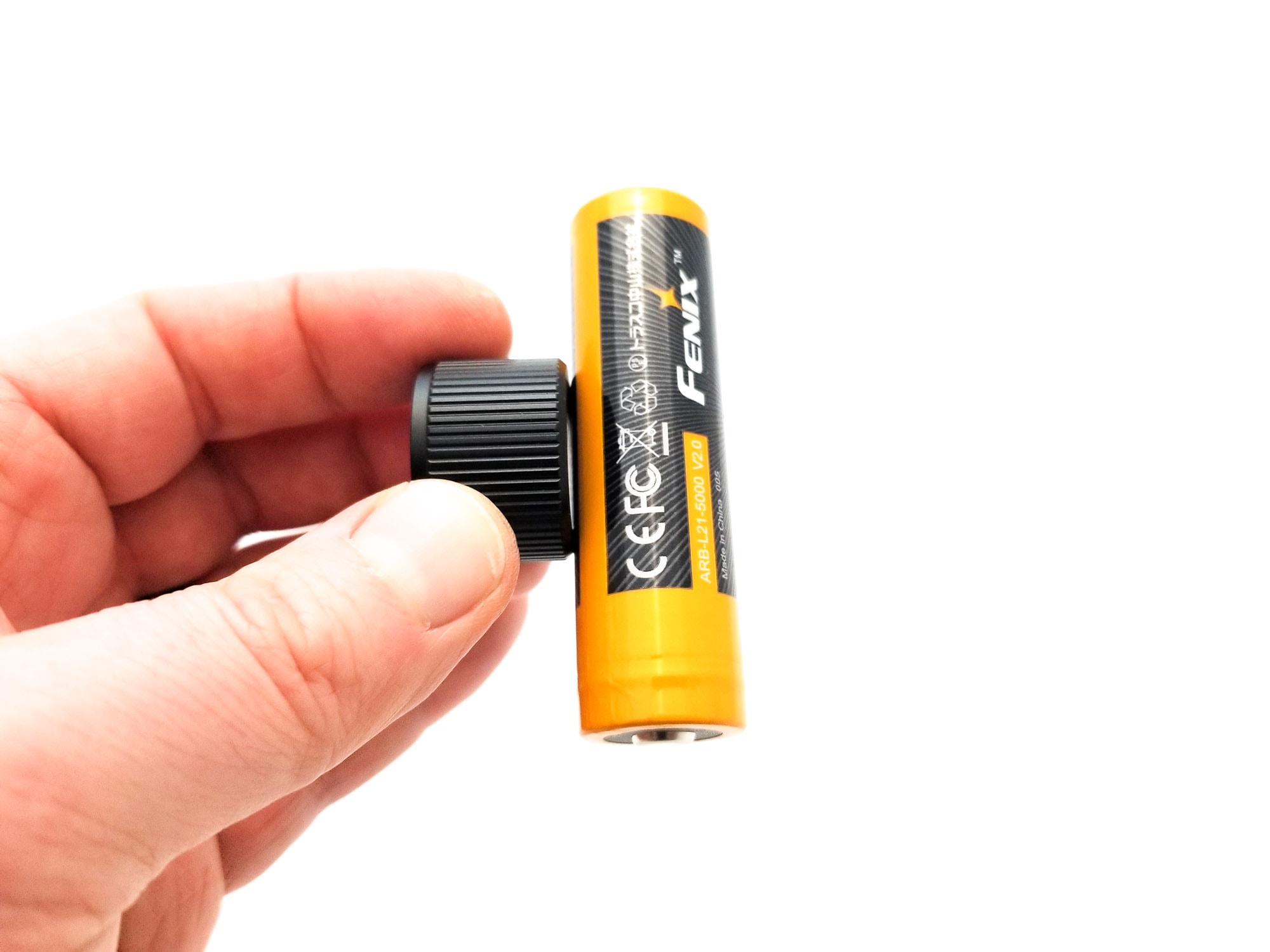
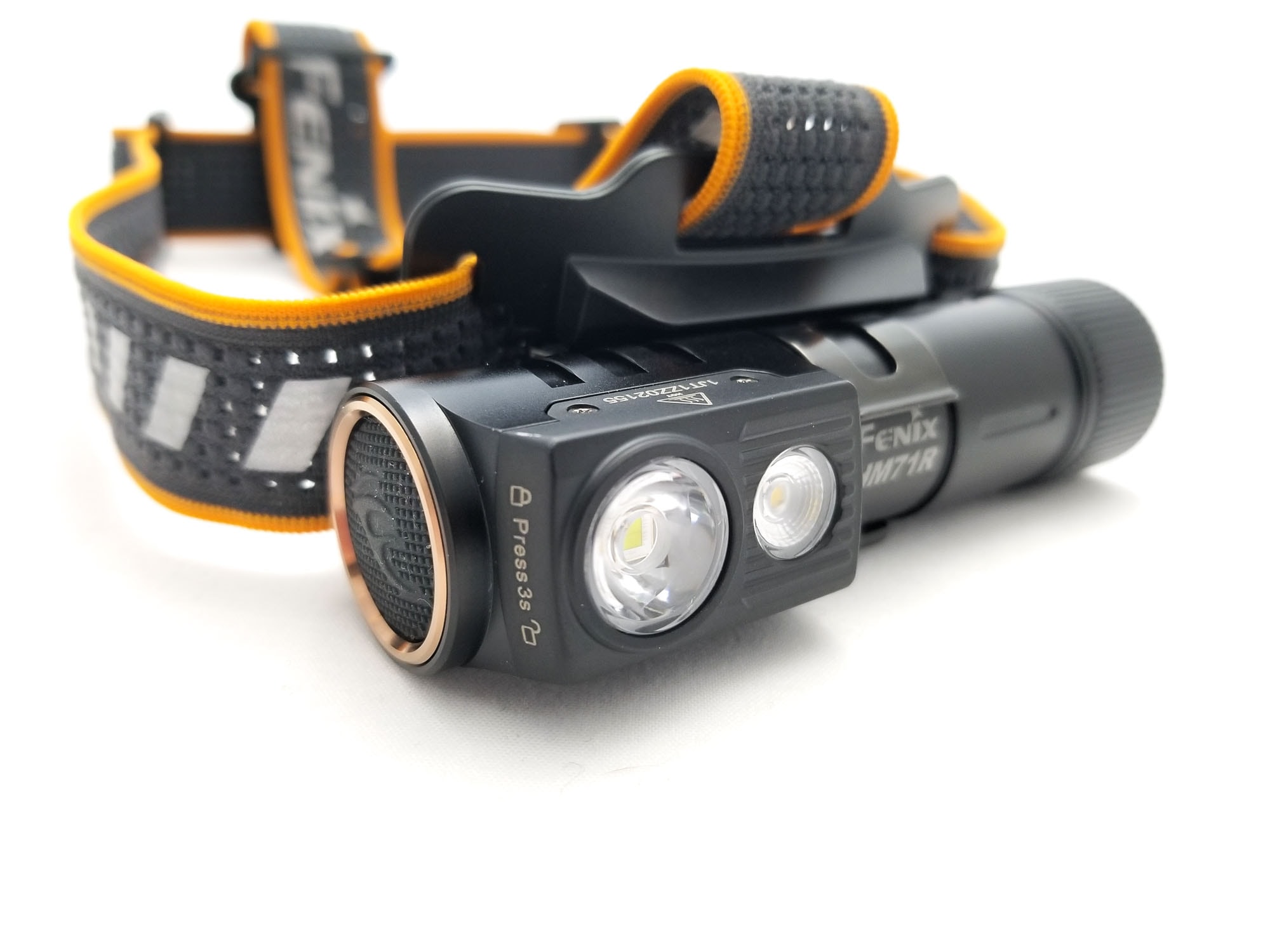
LED, Lens, Bezel, Beam, and Reflector
The HM71R utilizes 2 LEDs: A main LED and a flood LED. The main (spot) LED is pretty special and what makes the HM71R so special, since it’s one that I haven’t seen used in a headlamp before. The main LED is none other than the Luminus SFT70, and the flood LED is another Luminus product, the SST20. The SFT70 is a pretty special LED and normally rides in the reflectors of high output flashlights, so to see it moonlighting for headlamp duty has me chuffed to bits. It’s a fantastic LED with high output and high intensity for great throw, and it’s a 5050-size quad due LED, runs on 6 or 12 volts,like the older SST70. While it’s still a bond wire design, there’s dual wires for each anode and cathode, and the wires are potted in the die for better current handling. Like the SST70, it’s cool white for the CCT, around 6500K.
The flood LED is the Luminus SST20, and it has been around for a long time in a lot of consumer and enthusiast lights. It’s a 3 volt 3535 size LED, and comes in both cool white, neutral white, and warm white, low and high CRI varieties, which has made it an extremely popular LED within the industry. Fenix has recruited the warm white, high CRI version for duty in the HM71R, and while the bin is unspecified, it’s probably the FB4 variety 4000K 95 CRI. Both LEDs sit behind TIR optics, with the SFT70 behind a hybrid TIR with a hollow center, and the SST20 sitting under a uniquely designed reflector that looks like it belongs to a COB LED.
At 2 m from the sensor, the Opple Lightmaster Pro has the SST20 flood LED tint at 4104K and 95 CRI Ra. Duv is 0.0006 so a bit above the BBL.
The SFT70 is coming in 6400K and 68 CRI Ra with the duv at 0.0041.
The LEDs are very smartly selected, and the optics are nicely tuned for these LEDs. The spot LED produces a pronounced, large hotspot with diffuse spill and surprising reach and a lot of side illumination. The flood LED produces a lot of side illumination with evenly dispersed, warm, high CRI light. This is good for situations where accurate color reproduction is important, like inspection work, looking for cracks, tracing leaks, and for color matching (body work, painting, etc.). It’s about the perfect headlight/general purpose use beam. The spot beam has plenty of reach as well. Way to go Fenix!
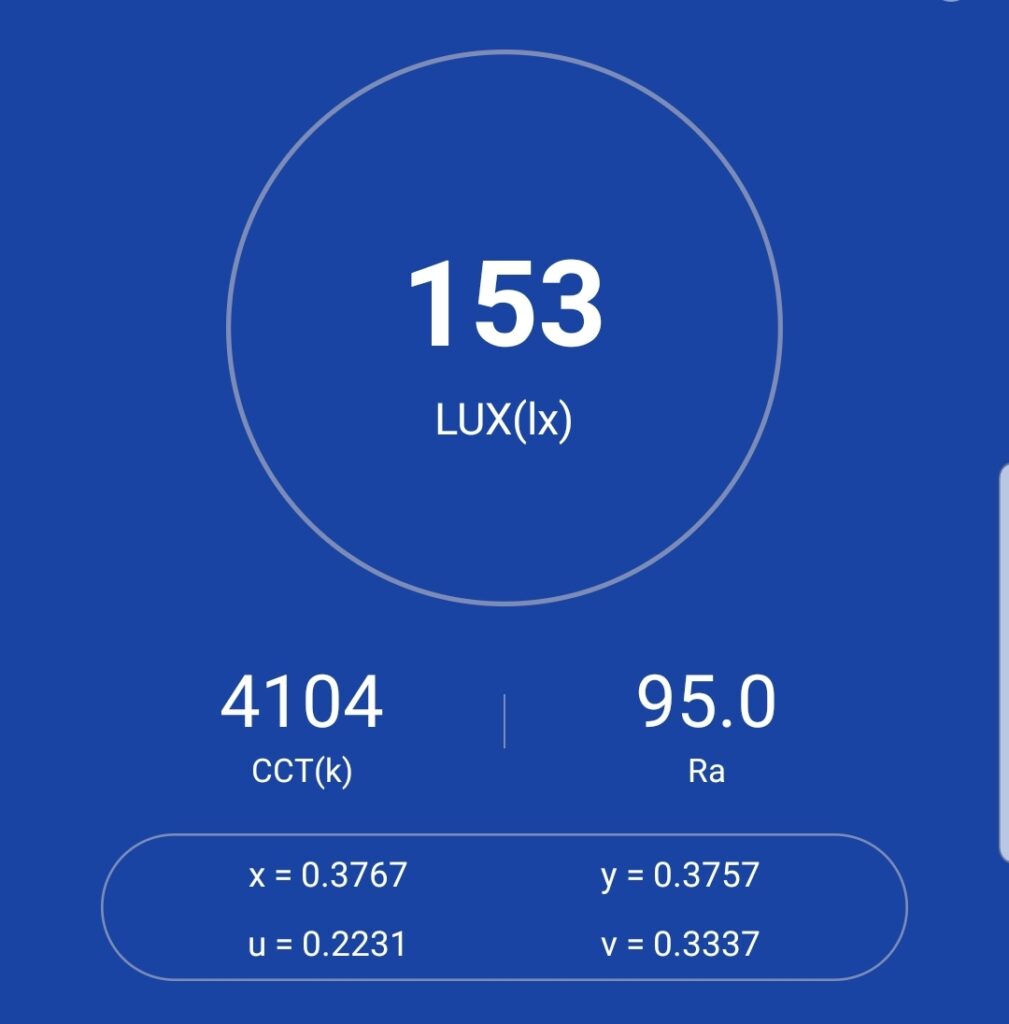
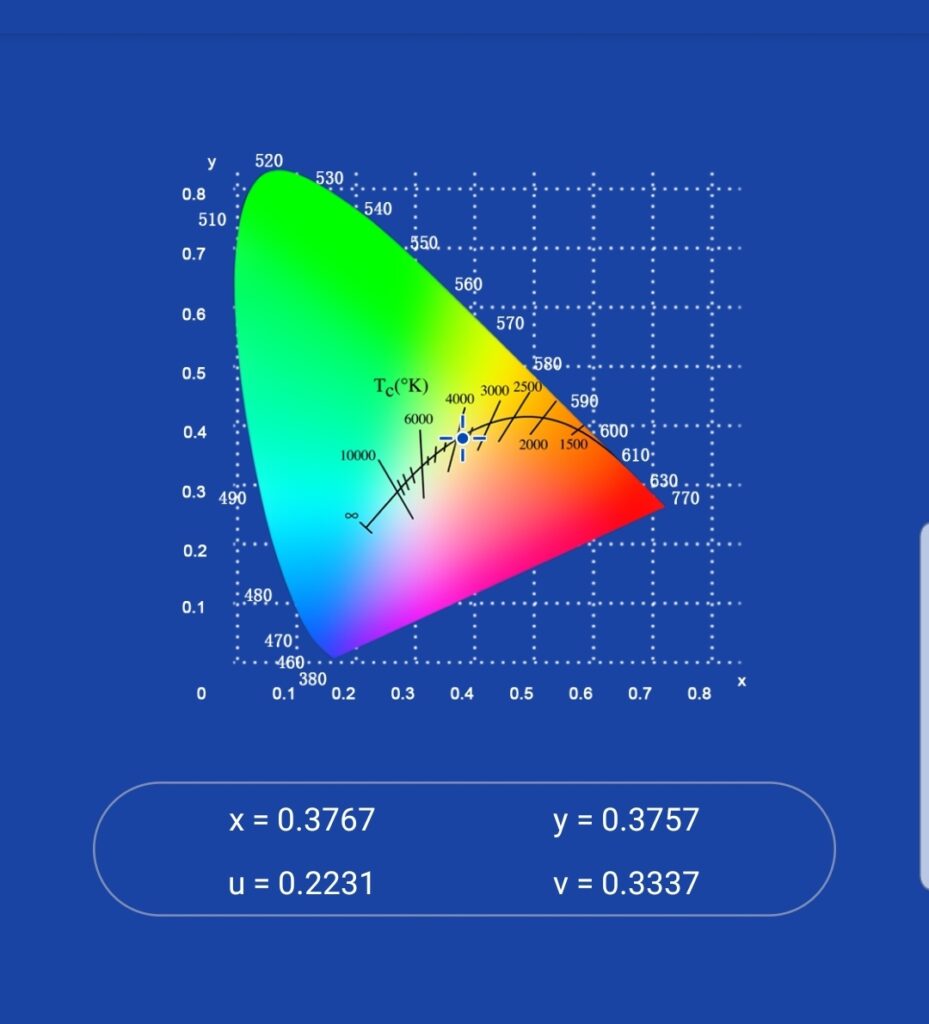
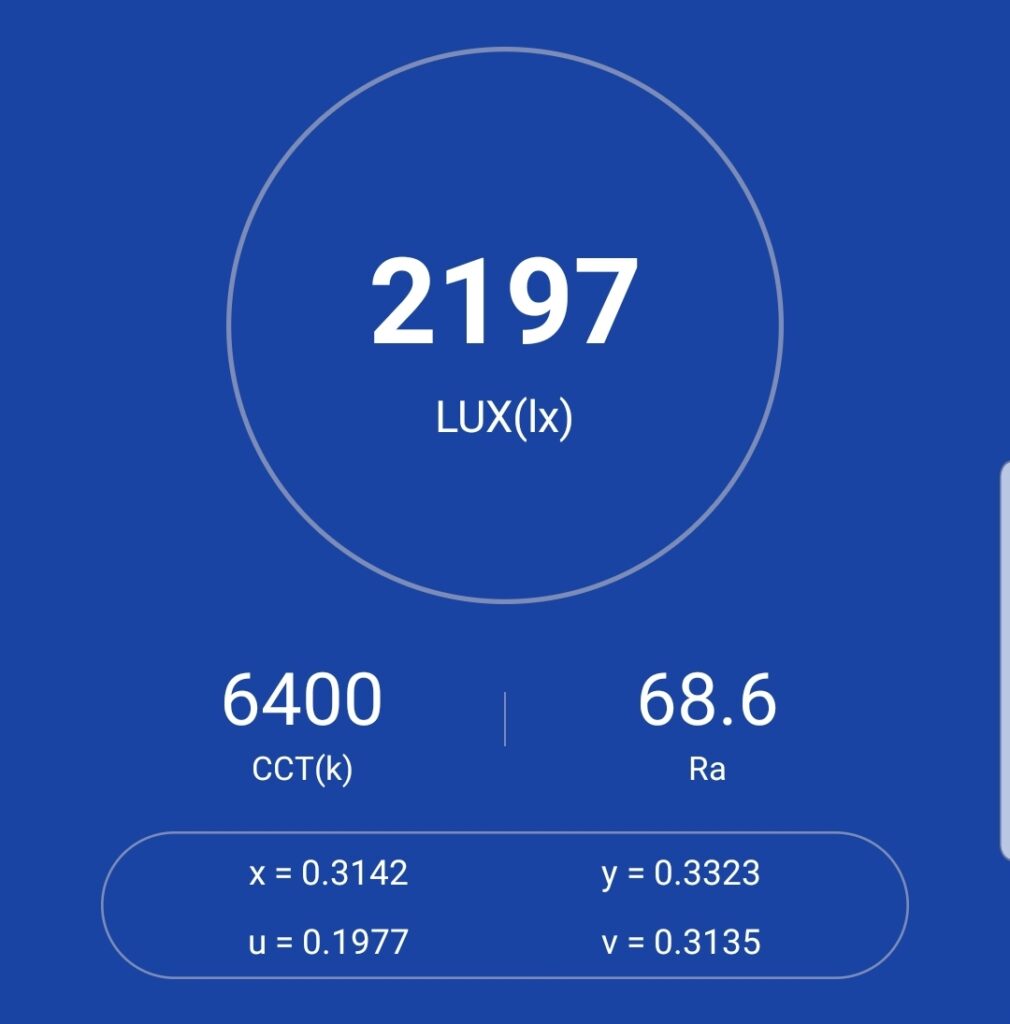
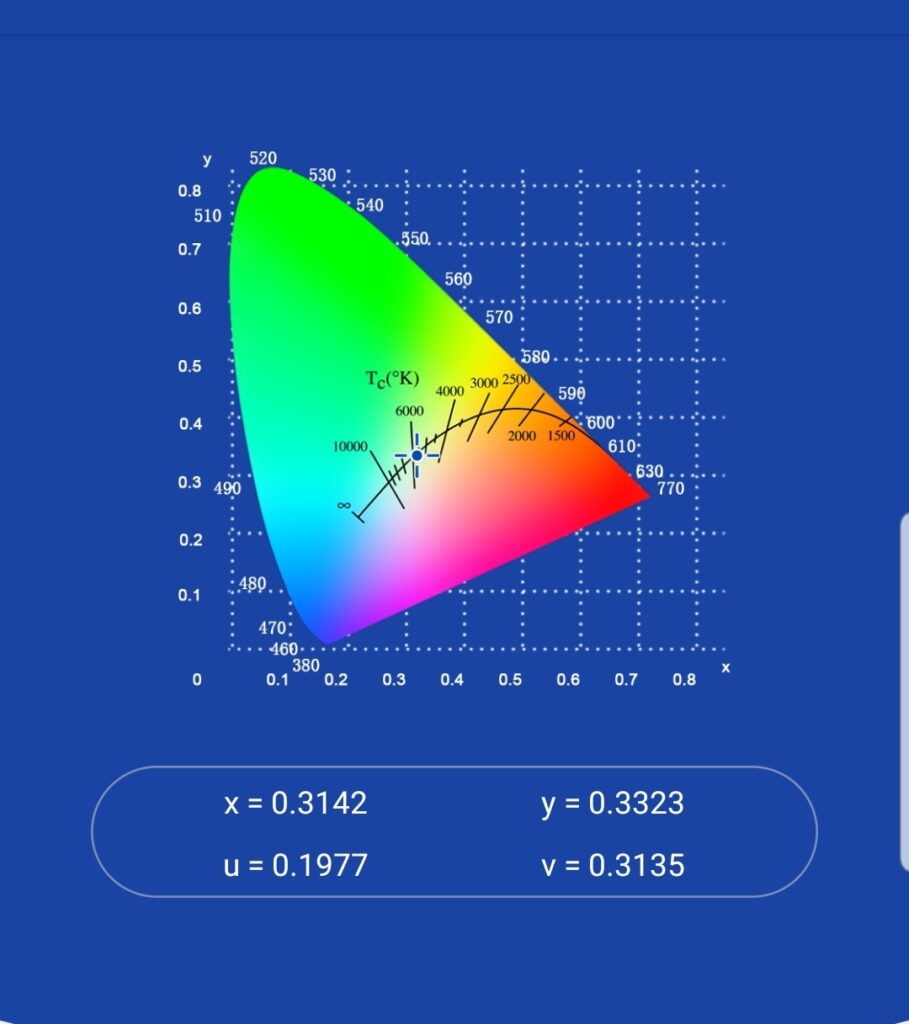
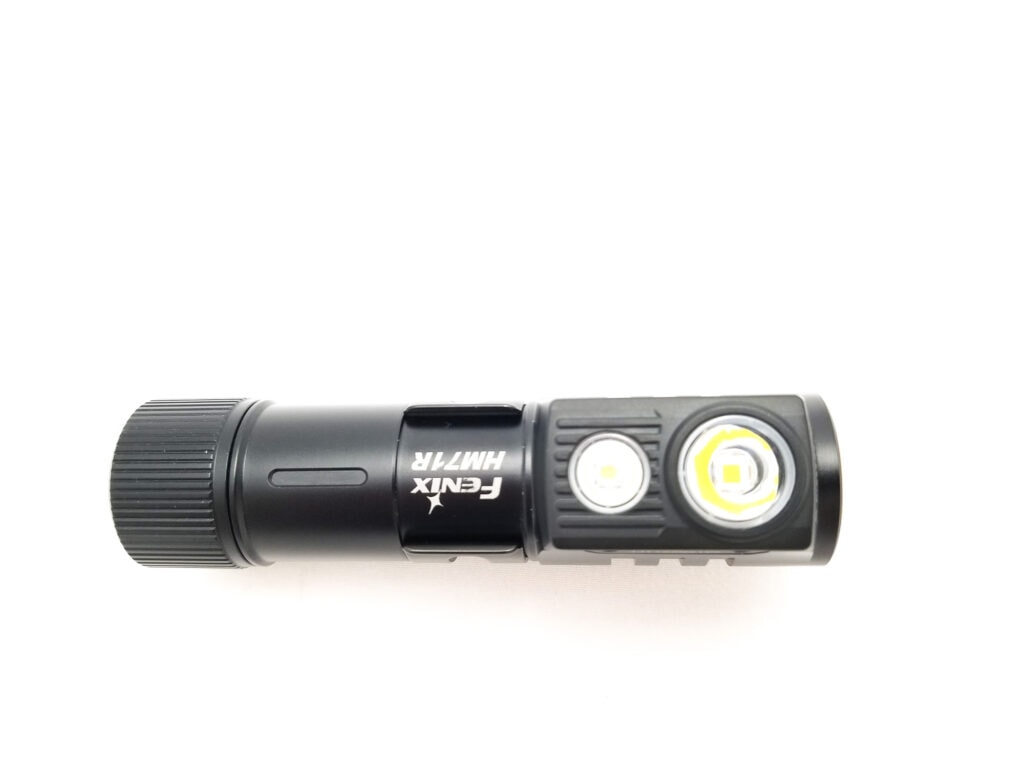
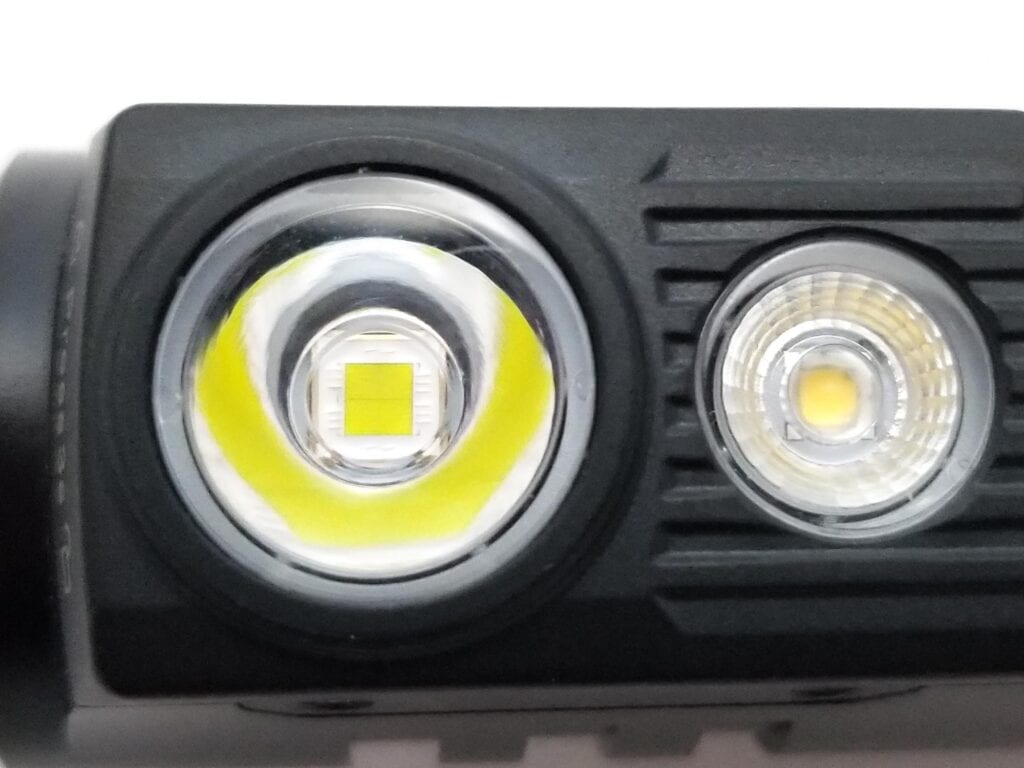
Dimensions and its competition
Dimensions:
| Fenix HM71R | Millimeters | Inches |
|---|---|---|
| Length | 106 mm | 4.1 in |
| Width | 46 mm | 1.8 in |
| Body diameter | 45 mm | 1.7 in |
Dimensions are rounded to the nearest millimeter, and to the nearest tenth of an Inch.
Weight:
| Fenix HM71R | Weight in grams | Weight in oz |
|---|---|---|
| Without battery, with headband: | 169 g | 6 |
| With battery and headband | 213 g | 8 |
| Without battery, no headband | 141 g | 5 |
Weight is rounded to the nearest gram, and to the nearest tenth of an Oz.
Overall,this is a pretty lightweight headlamp. Without the headband, it’s an even more handy and lightweight flashlight, but even though it’s a good bit heavier than a 18650 size headlamp, all things considered, and keeping in mind the gross weight is with a 5000 mAh cell onboard, it’s not bad.
Flashlight size comparison with its competition:
Compared to some of the best headlamps.
- Group 1 left to right: Fenix HM71R, Fenix HM70R
- Group 2 left to right: Fenix HM71R, Fireflies PL47G2 2021,
- Group 3 left to right: Fenix HM71R, BioLite 800 Pro
- Group 4 left to right: Fenix HM71R, Slonik D10
- Group 5 no headbands left to right: Fireflies PL47G2 2021, Slonik D10, Fenix HM71R
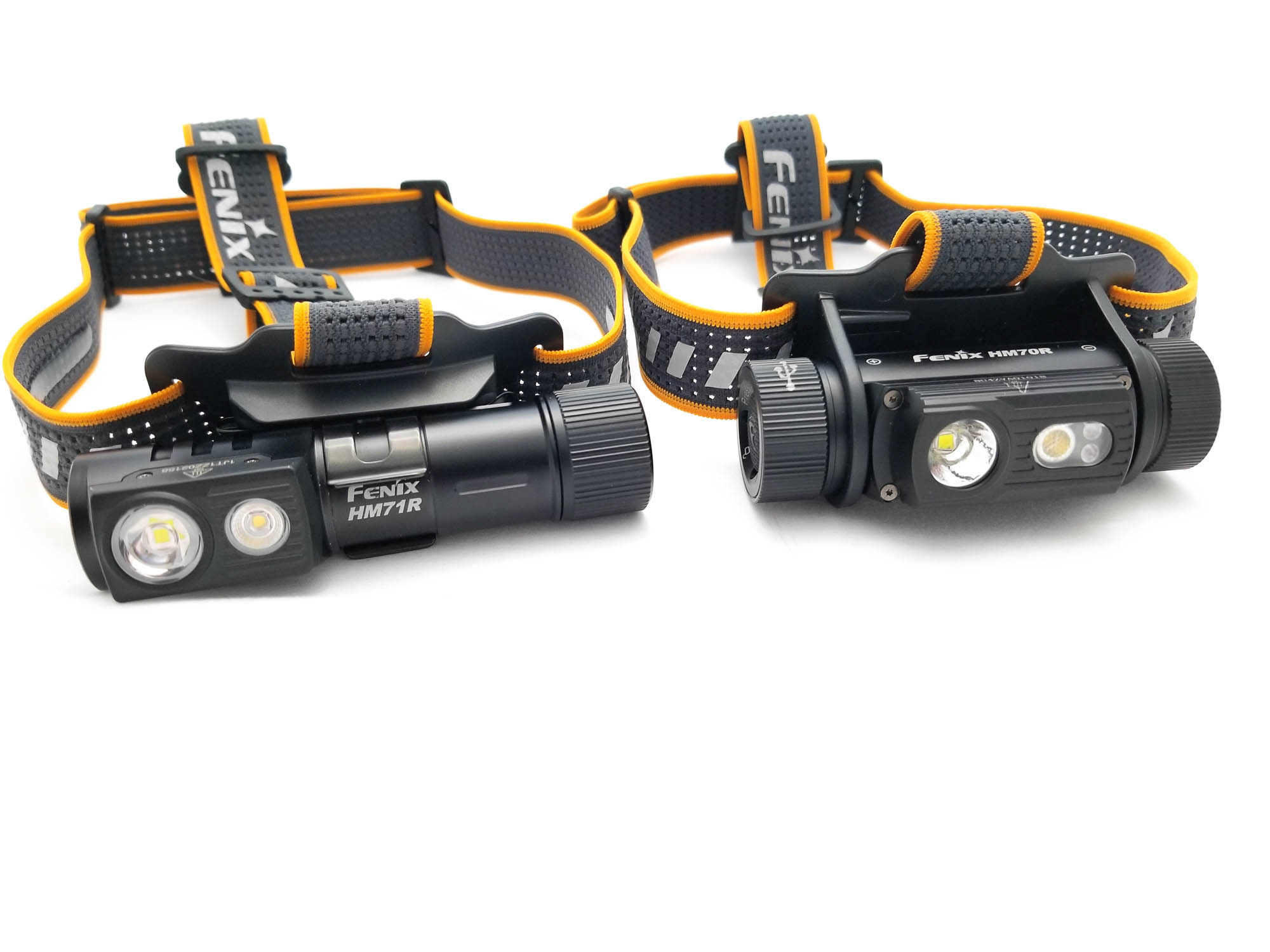
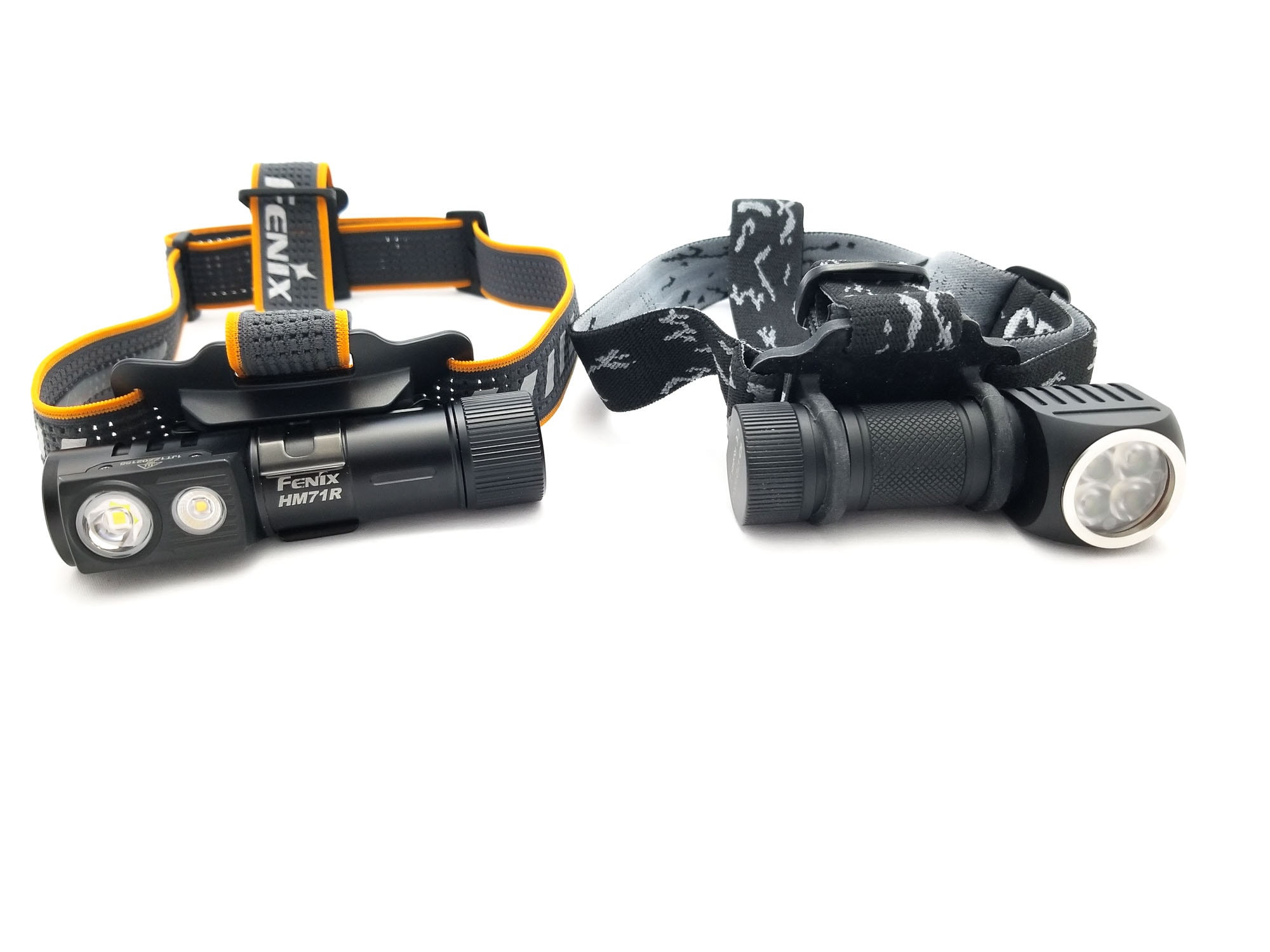
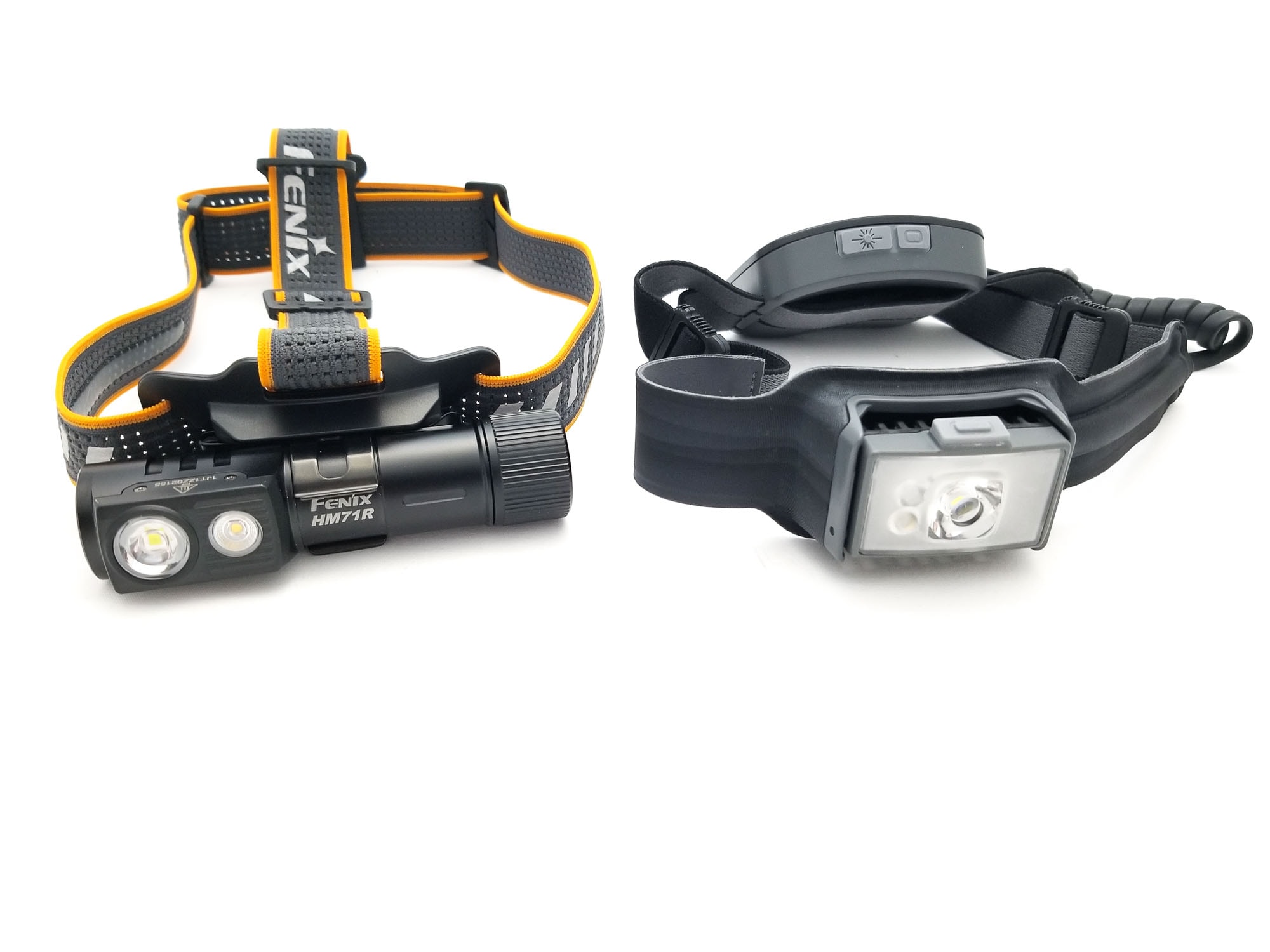
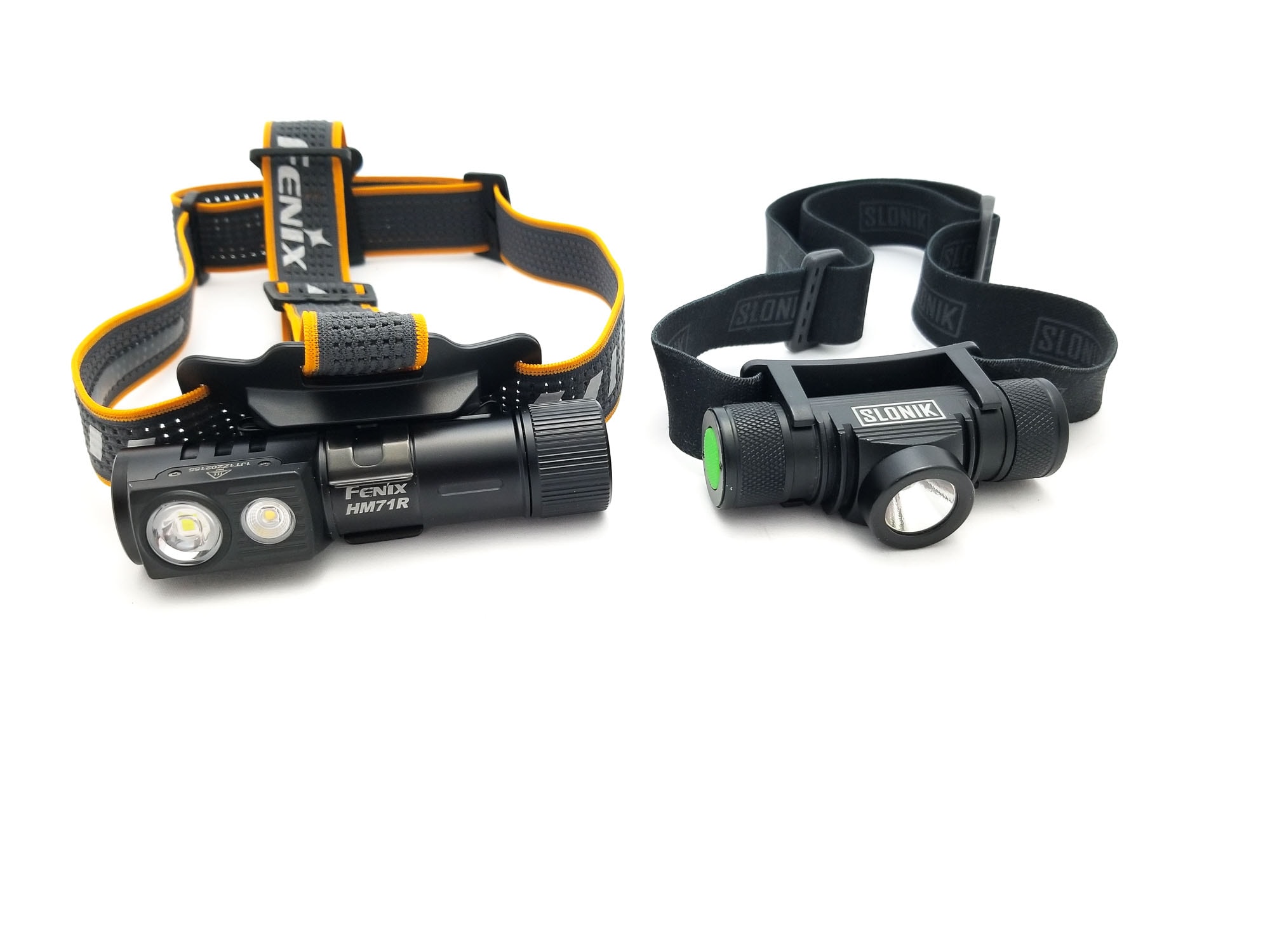

Fenix HM71R UI: User Interface and Driver
The driver is powering a 6 volt and a 3 volt LED. Could Fenix be fielding a buck/boost driver with 2 channels here, or maybe there’s two driver circuits? These drivers are superior to direct drive or linear drivers because they can maintain fully regulated output for much longer at higher outputs than a direct drive configuration since the output to the LED does not decrease as the battery drains.
For the UI, the HM71R employs a similar UI to the HM70R. LEDs are controlled by one switch and each LED has its own mode set. The spot LED mode set is called Spotlight Mode, the flood LED and red LEDs fall under the Floodlight Mode. To switch between the lighting modes, from on, press and hold the switch for about 1 second. The light turns off and then turns back on in the next mode group. If in Floodlight Mode, it switches to Spotlight Mode. In Spotlight Mode, it switches back to Floodlight Mode.
This is a pretty seamless way to manage multiple lighting modes, but it’s not without some drawbacks. More on that later.
Available modes for Spotlight Mode:
- Low, Medium, High, Turbo
Available modes for Floodlight Mode:
- Read (like a moonlight mode), Low, Medium, High
Available blinky modes:
- None
From OFF:
- Click and hold switch: Turns on in Spotlight Mode
- Click and hold switch for more than 3 seconds: Activates lockout
- Double click switch: Turns on in Floodlight Mode
From ON:
- Single click switch: Changes modes in the selected function
- Press and hold switch: Turns off
Mode memory:
- Last mode memory, but only in Floodlight Mode. The light will not remember Floodlight Mode if used last. Turbo in Spotlight Mode is not memorized (starts in High instead)
Shortcuts:
- Double click from off to access Floodlight Mode
Low voltage warning:
- The LED indicator shows battery state during operation: Solid green LED 100% to 85%, flashing green LED 85% – 50%, solid red LED 50% – 25%, flashing red LED 25% – 1%
Strobe/blinkies
- None
Lock-out mode:
- Manual lockout by unscrewing the battery access cap ⅛ turn or electronic lockout activated by pressing and holding the switch for 3 seconds. The red LED will blink to confirm, and will blink if the switch is pressed. Repeat to unlock.
PWM
- None visible
Additional/summary info on the UI: I’m a huge fan of dual switch headlamps with multiple lighting modes, and it’s difficult to implement a single switch UI that switches modes for each lighting mode group. Like the HM70R, Fenix has emulated that in the HM71R UI, but it’s still missing some useful features.
The modes are well-spaced in each lighting mode set, and although there’s no low moonlight, the ‘Read’ mode is pretty low. I like how they added two extra lighting levels for the flood LED, and I like how Turbo is included in the Spotlight Mode set by default.
I especially like that Floodlight Mode can be accessed from off with a double click. The only gripe I have is you don’t get mode memory for the Functional Mode. It’s only available in Spotlight Mode. That’s kind of a drag since I think the High setting on the Functional Mode is pretty useful, the beam is nice, and the tint is nice with the higher CRI.
Also, for low-light uses, it would be super annoying to click into the Low mode for the main LED in the dark. The red LED is a much better choice. LVP is present here, and the LED indicator is supposed to only be available when using the Fenix supplied battery, but I am sure LVP is built into the driver. You also can’t activate the spot and flood lighting modes simultaneously, which isn’t a huge deal, but would be nice. Fenix sets the ATR ceiling at 65 C, but these are temperature-limited step downs per Fenix, but can be reactivated when the light cools down.
Fenix HM71R Charging and batteries
The HM71R uses a single 21700 lithium ion cell, and Fenix includes their ubiquitous ARB-L21-5000 21700 cell with the light. This is a 5000 mAh protected button top light with a protection circuit. The 21700 has become the mainstream, go-to battery for high output flashlights, and while there’s more 18650 size headlamps, we don’t see many headlamps fielding this cell. It’s much higher capacity than an 18650, sporting up to 30% more capacity than the highest capacity 18650s and they can handle much higher current loading for longer. The tradeoff is increased size and weight, but compared to the 18650 size Cyansky HS6R, it’s not too much of a size and weight deficit, and worth the extra runtime.
Like some other Fenix flashlights, you can use your own batteries so long as they are button tops. The driver has interference bars on the side of the positive contact for reverse polarity protection, and that necessitates the use of button top batteries. I tried an Acebeam protected 21700 with USB charging and that one was way too long, but a button top Samsung 50G fit. Flat tops did not work. There’s USB type C onboard charging present as well. Charge current is advertised at 2 amps, so it should charge the battery in about 3 hours. My Ruideng AT35 USB tester showed 1.66 amps and 5.1 volts on a mostly depleted battery. C to C charging also worked fine. The battery was charged to 4.17 volts.
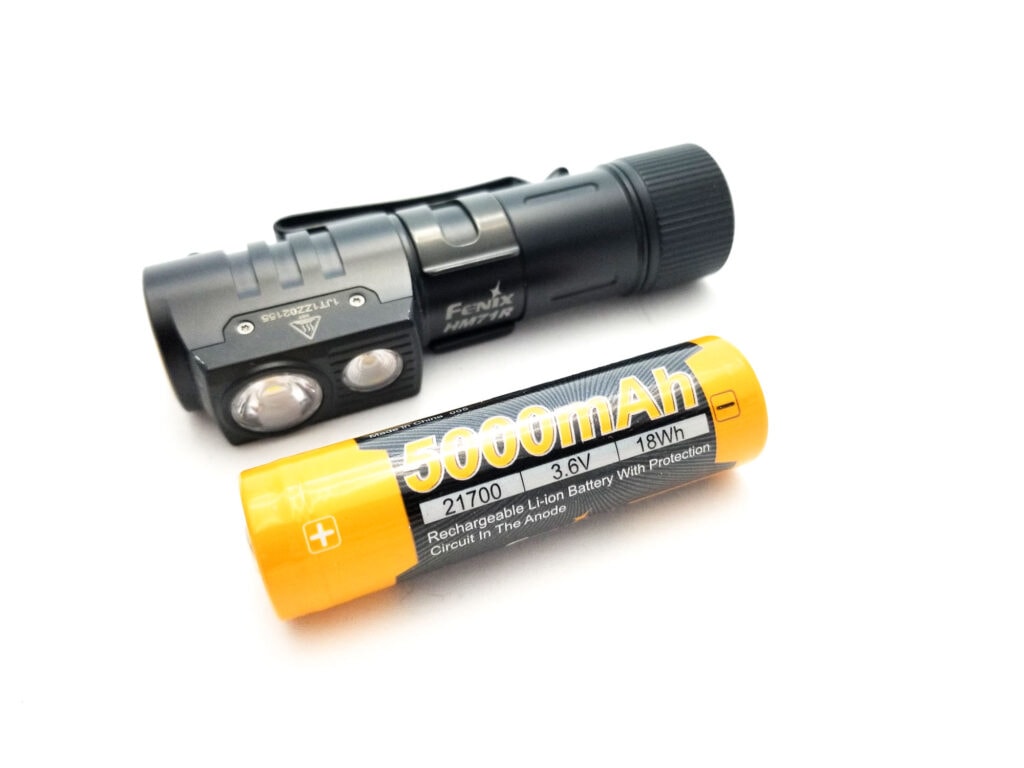
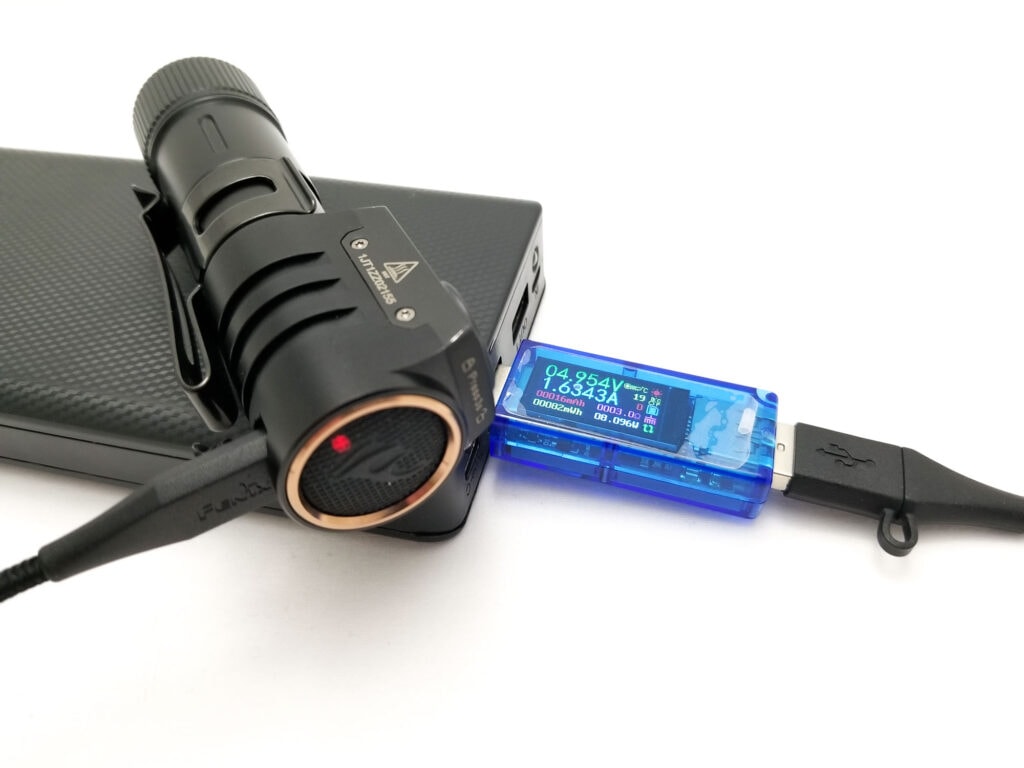
Performance test
Lumen measurements (for each mode)
How Lumens are Measured: Understanding ANSI FL1 Standards How Lumens are Measured: Understanding ANSI FL1 Standards: The ANSI FL1 standards specify that output in lumens should be measured 30 seconds after turning on, as this is the standardized time for measuring brightness according to the industry standard. This is why we focus on this part in our measurements. The ANSI FL1 standards require an ambient temperature of 22 ± 3°C. We record the ambient the ambient temperature to identify potential reasons for any observed discrepancies.The ANSI FL1 standards specify that output in lumens should be measured 30 seconds after turning on, as this is the standardized time for measuring brightness according to the industry standard. This is why we focus on this part in our measurements.
Lumens are measured in my 50 cm integrating sphere with a Digi-Sense 20250-00 data logging luxmeter. The sphere has been calibrated with a Convoy S2+ measured to 260 Lumens and the figures are within 10% of actual.
I used the included ARB-L21-5000 21700 and tested Medium, High, and Turbo modes with the flood and spot lighting modes. Amps were measured with my Thsinde B18B+ multimeter with 14 gauge wires directly in the meter, and FY19 clamp meter for current over 3 amps. Amp readings taken at turn on.
| Spotlight Mode | Amps | Specs | turn on | 30 sec | 10 minutes |
|---|---|---|---|---|---|
| Low | 88 mA | 50 | 48 lm | 48 lm | – |
| Med | 270 mA | 200 | 188v | 188 lm | 179 lm |
| High | 1.40 A | 800 | 725 lm | 725 lm | 713 lm |
| Turbo | 10 A (4.3 A at 30 sec) | 2700 | 2509 lm | 1746 lm | 971 lm |
| Floodlight Mode | Amps | Specs | turn on | 30 sec | 10 minutes |
| Read | 13.9 mA | 5 | 4 lm | 4 lm | – |
| Low | 190 mA | 50 | 59 lm | 59 lm | – |
| Medium | 500 mA | 200 | 220 lm | 218v | 220 lm |
| High | 2.0 A | 500 | 553 lm | 541 lm | 516 lm |
The output specs scale nicely with Fenix’s figures, and this is what I’ve come to expect from them, and as usual, you can trust Fenix output specs. The flood LED scales a bit higher than the spot LED, and that’s typical of my sphere that favors floody lights over more throwy lights. 2500 Lumens from Turbo on the spot LED is very impressive! It’s the highest output I’ve seen in a headlamp so far and more than enough light for just about any task. Even after 10 minutes, maintaining almost 1000 Lumens is equally impressive.
Parasitic drain:
- .03 mA, nice and low!
Battery Life: Runtime graphs
Lumens are measured in my 50 cm integrating sphere with a Digi-Sense 20250-00 data logging luxmeter. The sphere has been calibrated with a Convoy S2+ measured to 260 Lumens and the figures are within 10% of actual. I used the included Fenix ARB-L21-5000 21700 and tested Spotlight modes Medium, High, and Turbo mode, and Floodlight Modes Medium and High.
How Runtimes are Measured: Understanding ANSI FL1 Standards About ANSI FL1 runtime standards: The runtime is measured until the light drops to 10% of its initial output (30 seconds after turning on). This does not mean that the flashlight is not usable anymore. The last column shows how long the light actually works till it shuts off. If there is a + symbol, it means that the test was stopped at that particular point, but the light was actually still running. This happens on certain occasions, with certain drivers, firmware, or batteries.| Spotlight Mode | Specified runtime | Measured runtime ANSI FL1 | Time till shut off |
|---|---|---|---|
| Med | 16h | 16h 12m | 16h 12m |
| High | 5h | 4h 41m | 4h 57m |
| Turbo | 3h | 2h 53m | 3h 19m |
| Floodlight Mode | |||
| Medium | 16h | 16h 12m | 16h 12m |
| High | 8h | 4h 27m | 4h 38m |
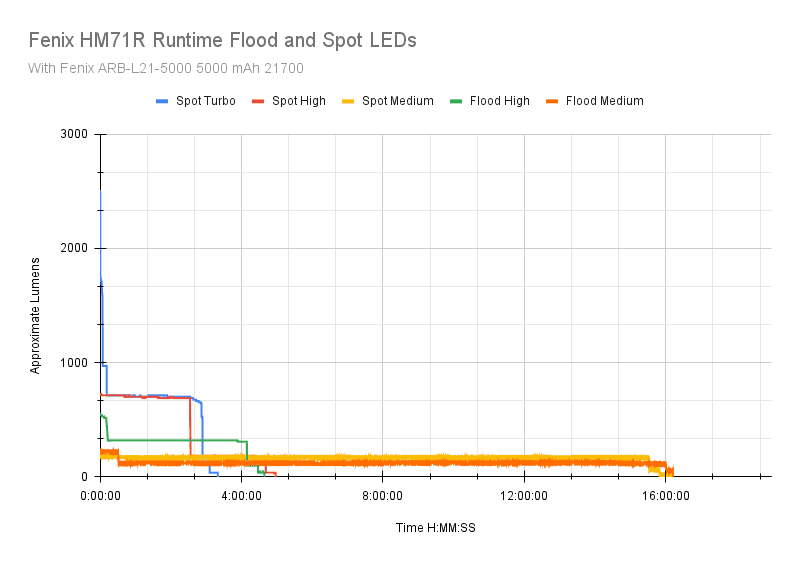
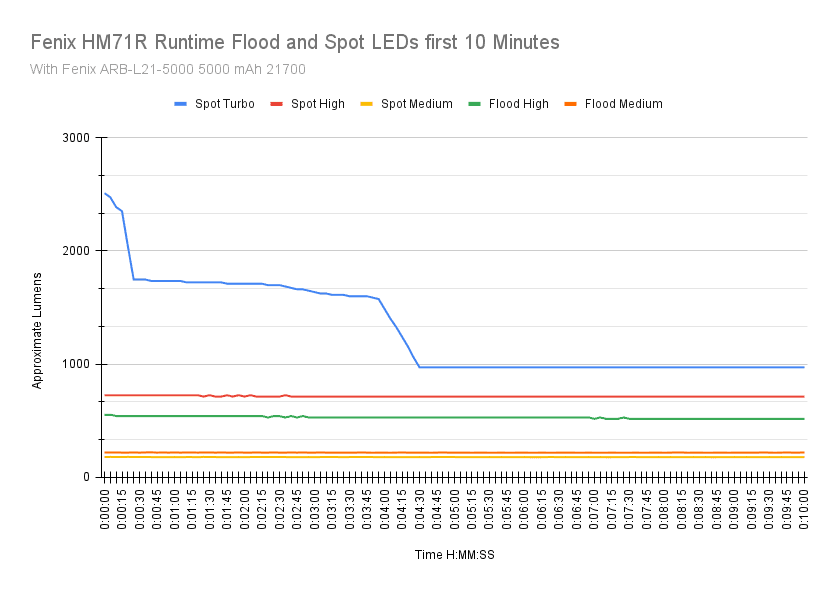
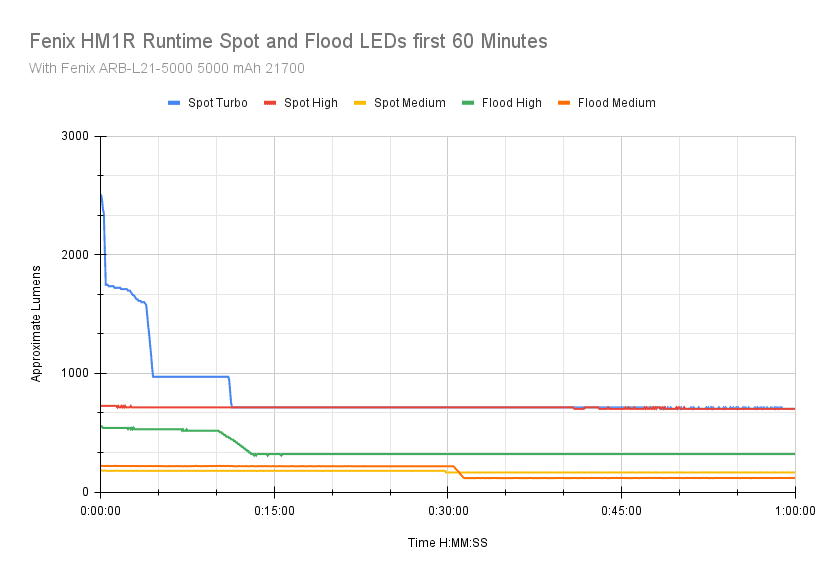
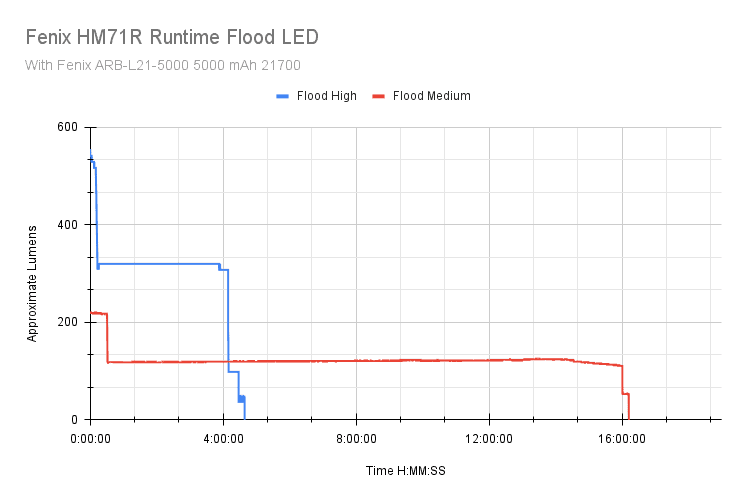
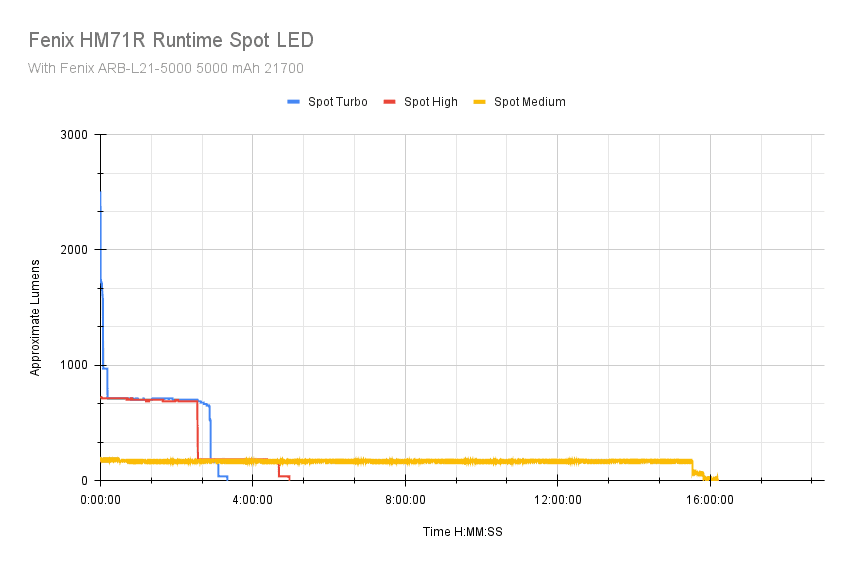
Once again it’s typical Fenix here with the runtimes as well, with everything looking really close to the factory specs…except for High on the floodlight mode, which on the first runtime test came in at ANSI 4 hours 27 minutes, and 4 hours 38 minutes to shut down. What’s this? The floodlight’s High mode must have had a rough day at the office since it called it quits over 3 hours early. I ran the test again and nearly duplicated it, which is highly unusual for Fenix since they use the same battery for their lab testing.
The driver on this light is nicely regulated and well-matched for the LEDs. Every lighting mode has great regulation. The temps were also kept in check very nicely as well. Even on Turbo for the spotlight LED pulling 10 amps, the head heated to 45 C max, and never went over that the entirety of the runtime. None of the other modes, except for the High floodlight mode, got over 50 C, so even if you went handheld with the HM71R, it’s still comfortable to hold at high output for extended periods. Even on Turbo, you get better than 1000 Lumens for over 4 minutes, and almost 1000 Lumens for another 7 minutes. The floodlight mode is nicely regulated as well. All good stuff. LVP worked fine, dropping the output very low, and finally shutting down. The light was usable after each test at lower outputs, and the battery read 2.93 volts after each run.
Peak beam intensity and beam distance measurements
Beam distances are measured using a Uni-T UT383S luxmeter measured indoors at 5 meters using the included fully charged ARB-L21-5000 21700. Measurements taken at 30 seconds.
| Spotlight Mode | Specs | Candela measured | Meters | Yards |
|---|---|---|---|---|
| Low | 181 | 150 | 24 | 26 |
| Medium | 686 | 700 | 53 | 58 |
| High | 2705 | 3225 | 115 | 126 |
| Turbo | 13,300 | 7525 (9575 at start) | 173 (196 at start) | 189 (214) |
| Floodlight Mode | Specs | Candela Measured | Meters | Yards |
| Read | 6 | N/A | N/A | N/A |
| Low | 50 | N/A | N/A | N/A |
| Medium | 225 | 200 | 28 | 31 |
| High | 555 | 625 | 50 | 55 |
These are decent numbers, and in line with Fenix’s figures for beam distance. The Turbo figure is down from the advertised candela though by quite a bit, and the output has dropped a bit by the 30 second mark. Still, his is about what I expect from a headlamp of this type, and it’s more than enough distance for just about every task. I did not get a reading from the floodlight Read and Low modes at 5 meters.
About Peak beam intensity: Understanding ANSI FL1 Standards About peak beam intensity The calculated value of distance in meters at which the flashlight produces a light intensity of 0.25 lux. (0.25 lux is about the brightness of a full moon shining on an object). This means that the intensity has decreased so much, it becomes difficult to see darker objects, or objects that don’t reflect light. The columns ‘Meters’ and ‘Yards’ use rounded numbers.Beamshots
I compared the HM71R to some other headlamps. Photos taken with my Samsung Note 8. The outdoor 40 meter shots with the camera set to 0.3s ISO 200 and 5000K WB.
Beamshots of the following headlamps compared:
- Fenix HM71R
- Fenix HM70R
- Slonik D10
- BioLite 800 Pro (flood, spot)
- Cyansky HS6R (flood, spot, flood+spot)
- Cyansky HS3R
- Fireflies PL47G2 2021
- Fireflies PL47G2-Mu (mule)
- Brinyte HL18














Disclaimer: This flashlight was sent to me for review at no cost by Fenix Lighting US. I have not been paid to review, nor have I been holding back on problems or defects.
Final Verdict
Pros
- Great build quality
- Regulated output
- Simple, intuitive UI
- Onboard USB type C charging
- Versatile headlamp or flashlight
- Non-proprietary 21700 battery
Cons
- Can’t activate flood and spot lighting modes simultaneously
- No mode memory for the flood mode
- Flood LED High mode runtime was much shorter than spec
- Doesn’t reach claimed output
Explanation on star ratings:
1: Avoid: a match would be a better choice – 2: Poor: significant defect or issues; almost unusable – 3: Average: some defects or issues; but still usable 4: Good: recommended (minor issues) – 5: Great: highly recommended

4.5 stars: ★★★★⋆
While our star rating provides a reliable indicator, we encourage you to read the full review to make an informed decision based on your own needs and preferences.
How do you make a better headlamp? Ask Fenix! They’ve been making lighting tools for a long time, build on feedback from pros and regular folks, and continuously improve, and this experience shows in the releases of products like the HM71R. While this isn’t a new design, or even a new concept for headlamps, it’s how Fenix implemented everything because this HM71R manages a perfect balance of performance and versatility. There’s not much I don’t like, and aside from the lingering inability to activate flood and spot modes simultaneously, and missing mode memory for the flood mode carried over from the HM70R, there’s not many strikes on this one.
The High mode for the flood LED runtime was way down for some reason, and my retest pretty much duplicated it, so I’m not sure what’s going on there. The HM71R just does a lot of things well. It does great as a headlamp, and really shines as a utility light. It’s a very handy general purpose handheld flashlight as well that’s surprisingly pocketable. I liked the quick release headband mount, and 2500 Lumens on Turbo (albeit brief) isn’t too shabby.
Fenix consistently delivers on the great build quality, fit, and finish as usual. The fact you can bring your own 21700 is another plus when other companies in this price bracket are going proprietary with their batteries. Overall, I think this is a great headlamp/flashlight. It’s built tough and should stand up to abuse and use. If you’ve got a thing for right angle headlamps and the budget for it, I recommend picking one up. 4.5 stars for the HM71R.
Buy your Fenix HM71R with a discount
Get 10% off every purchase at Fenix Lighting US, by using our exclusive 1lumen discount code: 1lumen10
Get 10% off every purchase at Fenix Lighting US, by using our exclusive 1lumen discount code: 1lumen10
1lumen selects and reviews products personally. We may earn affiliate commissions through our links, which help support our testing.